Home » Posts tagged 'google voice' (Page 17)
Tag Archives: google voice
The Asterisk Mother Lode: Introducing Incredible PBX 4.0 with FreePBX 2.10
 We thought we’d start your summer off with a bang by introducing an all-new Incredible PBX™. So what’s new? 50 Asterisk® Apps. 9-Layer Security. 20 Preconfigured VoIP Provider Trunks. 1-Click Installers for Asterisk.everything. FreePBX® 2.10. Certified Asterisk support. And what’s the same? It’s all still FREE!
We thought we’d start your summer off with a bang by introducing an all-new Incredible PBX™. So what’s new? 50 Asterisk® Apps. 9-Layer Security. 20 Preconfigured VoIP Provider Trunks. 1-Click Installers for Asterisk.everything. FreePBX® 2.10. Certified Asterisk support. And what’s the same? It’s all still FREE!
Coming January 19: Incredible PBX 11 & Incredible Fax for Asterisk 11 and FreePBX 2.11
Coming February 11: Incredible PBX 10 & Incredible Fax for 64-bit Asterisk 1.8 and FreePBX 2.10
We heard you. Yes, we needed Incredible PBX™ support for FreePBX 2.10 with Asterisk 1.8. And today it’s finally here. Incredible PBX 4.0 brings all of the original Asterisk applications plus more than a dozen new turnkey applications released in 2012 and an all-new level of security to protect your phone bill. The installation process is so simple a monkey could do it. You still can add Incredible Fax 2.0™ to deliver free faxing with HylaFax™ and AvantFax® in a setup process that’s as simple as pressing the Enter key. When you’re finished, you’ll have one of the open source wonders of the world with free phone calls and faxing throughout the U.S. and Canada together with almost every Asterisk application ever developed. There’s more good news. You don’t have to be smarter than a fifth grader to get any of it installed and working reliably with Asterisk. Just run the simple install script, and presto.
July Update: Incredible in the Cloud. For those that would prefer to run Incredible PBX 4.0 in the Cloud, RentPBX now is offering a pre-built image with PIAF-Brown and FreePBX 2.10 that is ready to go using servers all around the world. On your first order, Incredible in the Cloud is just $15/month using coupon code PIAF2012. Sign up at this link.

August 15 Update: Incredible Pi. We needed a back-to-school project, and this year we’ve chosen to port most of the Incredible PBX feature set to the new $35 Raspberry Pi. Thanks to the pioneering work of Gernot, this was fairly straight-forward. We’re still aiming for an early September release but, if you’d like to get a head start, you can order your device and follow our progress on the PIAF Forum.
If you’re curious why we no longer are supporting Asterisk 10, read all about it in last week’s Nerd Vittles article. Suffice it to say, if Digium is unwilling to fully support the platform, then we think it is a dead-end product. Unfortunately, this further splinters Asterisk development. In addition to long-term support (LTS) releases, "certified" (SLA) releases, and "other" releases, we now have a new category for Digium-supported modules and "community modules." To us, this signals the death knell for modules which Digium is no longer willing to actively support. Consequently, we will no longer recommend Asterisk 10 for production use. And we continue to be nervous about what the future holds for Google Voice support in Asterisk 1.8 and Asterisk 11 as well. The good news is, if you read last week’s article, you already know we have a rock-solid alternative waiting in the wings. YATE rocks! And FreeSentral is no slouch either.
 The Incredible PBX 4 Inventory. For those that have never heard of The Incredible PBX, here’s the current 4.0 feature set in addition to the base install of PBX in a Flash with the CentOS 6.2, Asterisk 1.8 or Certified Asterisk 1.8, FreePBX 2.10, and Apache, SendMail, MySQL, PHP, phpMyAdmin, IPtables Linux firewall, Fail2Ban, and WebMin. Cepstral TTS, Incredible Fax, Skype, NeoRouter and PPTP VPNs, and all sorts of backup solutions are still just one command away and may be installed using the scripts included with Incredible PBX 4 and PBX in a Flash. Type help-pbx and browse /root and /root/nv for dozens of one-click install scripts.
The Incredible PBX 4 Inventory. For those that have never heard of The Incredible PBX, here’s the current 4.0 feature set in addition to the base install of PBX in a Flash with the CentOS 6.2, Asterisk 1.8 or Certified Asterisk 1.8, FreePBX 2.10, and Apache, SendMail, MySQL, PHP, phpMyAdmin, IPtables Linux firewall, Fail2Ban, and WebMin. Cepstral TTS, Incredible Fax, Skype, NeoRouter and PPTP VPNs, and all sorts of backup solutions are still just one command away and may be installed using the scripts included with Incredible PBX 4 and PBX in a Flash. Type help-pbx and browse /root and /root/nv for dozens of one-click install scripts.
- AsteriDex
- Asternic CDR Reports
- Baseball Scores & Schedules
- CallerID Superfecta (FreePBX Module adds Names to CID Numbers)
- SIP Color Videophone Support
- CallWho for Asterisk
- CDR CallerID Name Support (Inbound and Outbound Calls)
- Cepstral TTS (/root/nv/install-cepstral)
- Digium Phone Support (install-digiphones)
- Preconfigured Email That Works with SendMail
- Endpoint Manager for PIAF (install-epm)
- ENUMPLUS (Use FreePBX to configure)
- Extensions (16 preconfigured with random passwords)
- Festival Server and Festival TTS for Asterisk (festival –server &)
- Flite TTS for Asterisk
- FONmail
- FreePBX Backups
- Google Dictionary by Phone (Dial 333)
- Google News by Phone (Dial 951)
- Google Stocks by Phone (Dial 950)
- Google Voice (FreePBX Module)
- Hotel-Style Wakeup Calls (FreePBX Module)
- Incredible Backups… and Restores (install-incredbackup2)
- ISN: FreeNum SIP Calling from Any Phone
- MeetMe Conference Bridge (just dial C-O-N-F)
- Mondo Full System Backups (install-diskbackup)
- Incredible Fax 2 (install-incredfax2)
- Incremental Daily Backups (install-dailybackup)
- Munin Reports (install-munin)
- NeoRouter VPN Client (nrclientcmd)
- NeoRouter VPN Server (/root/install-neorouter)
- NewsClips from Yahoo
- ODBC Database Support
- OpenFire Instant Messaging & Chat Server (install-openfire)
- New PBX in a Flash Registry (show-registry)
- PPTP VPN for PIAF (/root/install-pptp)
- Reminders by Phone and Web
- SAMBA Windows Networking (configure-samba)
- Silk Codec (install-silk)
- Siren Codecs (install-siren)
- SIP URI Outbound Calling (call any SIP URI worldwide for free)
- Free Skype Inbound & Outbound Calling (install-skype2)
- SMS Dictator with Google Voice (/root/sms-dictator.sh)
- Speech-to-Text Directory Assistance (Dial 412)
- Stealth AutoAttendant
- Sugar CRM (install-sugarcrm)
- TeleYapper
- TFTP Server (setup-tftp)
- Tide Reports with xTide (Dial T-I-D-E)
- Travelin’ Man 2 & 3 (Secure, remote access)
- Trunk Lister Script (/root/nv/trunks.sh)
- Trunks (Vitelity, Gtalk, SIPgate, IPkall, VoIP.ms, and ENUM)
- Twitter Interface (Make Free Calls and Send SMS Messages)
- Weather by Airport Code
- Weather by ZIP Code
- Worldwide Weather by Phone (Dial 949)
- Wolfram Alpha by Phone (/root/wolframalpha-oneclick.sh)
And then there’s the Incredible Freebie! As they say, "Never look a gift horse in the mouth." What began as a kludgey, dual-call, dual-provider Google Voice implementation to take advantage of Google’s free PSTN calling in the U.S. and Canada with Asterisk 1.4 and 1.6 is now a zippy-quick, Gtalk-based calling platform that rivals the best SIP-to-SIP calls on the planet. The Incredible PBX Google Voice implementation provides virtually instantaneous PSTN connections to almost anybody, anywhere. Trust us! Except for the price which is still free, you’ll never know you weren’t connected via Ma Bell’s overpriced long-distance lines and neither will the Little Mrs. And, yes, our recommended $50 Nortel SIP videophone is plug-and-play.
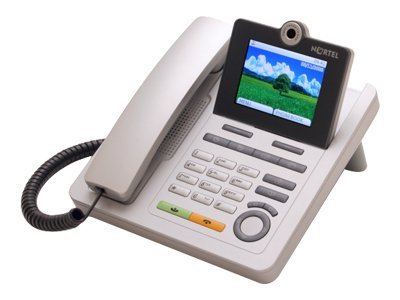
To get started, download the latest 32-bit PBX in a Flash 2.0.6.2 ISO from SourceForge, burn to then boot from the PIAF2 CD, choose the PIAF-Purple option to load Asterisk 1.8 or PIAF-Brown to load Certified Asterisk, and pick FreePBX 2.10 when prompted. Once the PIAF2 install is completed, just run the new Incredible PBX 4.0 installer. In less than an hour, you’ll have a turnkey PBX with a local phone number and free calling in the U.S. and Canada via your own Google Voice account plus over 50 terrific Asterisk applications to keep you busy exploring for months.
A Few Words About Security. Thanks to its Zero Internet Footprint™ design, Incredible PBX 4 is different. It remains the most secure Asterisk-based PBX around. What this means is The Incredible PBX™ has been engineered to sit safely behind a NAT-based, hardware firewall with no Internet port exposure to your actual server. For those needing remote telephone support, Incredible PBX loads Travelin’ Man 2 and 3 for you so your IPtables Linux Firewall can be either self-managed by end-users or set up with predefined IP addresses and FQDNs for all of your remote sites. If you’ve read about Asterisk’s latest SIP vulnerability published just last week and occurring almost as often as you tie your shoes, then you’ll understand why WhiteList-based server security has become absolutely essential. WhiteList Security means only those devices with a registered IP address in your WhiteList can get to your server’s resources. To everyone else, your server doesn’t even exist. Their only way to connect to you is with a POTS telephone and your published phone number.
For those with multiple servers to interconnect, we’ve provided one-click installers for not one but two VPN solutions: NeoRouter and PPTP. Suffice it to say, Incredible PBX has Security in Spades™: customized IPtables Linux Firewall, Fail2Ban tweaked for Asterisk security monitoring, FreePBX Extension Lockdown by IP address, randomized FreePBX extension passwords, Travelin’ Man 2 and 3 WhiteList Security, multiple VPN solutions for encrypted server-to-server communications, plus a bottom-up design focused on flawless operation behind a hardware-based firewall. You won’t find a more secure Personal Branch Exchange™ at any price.
Here’s the Incredible PBX 9-Layer Security Model:
- Hardware-based Firewall
- IPtables
- Fail2Ban
- Randomized Extension Passwords
- IP-Address Lockdown for Extensions
- Travelin’ Man 2 User-Managed WhiteList
- Travelin’ Man 3 Administrator-Managed WhiteList
- NeoRouter VPN
- PPTP VPN
Prerequisites. Here’s what we recommend to get started properly:
- Broadband Internet connection
- $150 Single or Dual-Core Atom PC, 4GB RAM, 60GB SSD (no moving parts!)
- dLink Router/Firewall. Low Cost: $35 WBR-2310 Best: DGL-4500 Latest: DIR-826-L
- Dedicated Google Voice account (not your main Gmail account!)
We’ve shifted gears on our recommended Atom platform for PIAF2 after excellent results with both the single-core and dual-core Atom kits manufactured by Foxconn (pictured on the left below). That’s the dLink Gaming Router on the right. Seems kinda silly to spend twice as much for a machine that you can build yourself in under 5 minutes. Basically you remove four screws, insert a Phillips screwdriver in one of the holes and gently pry the cover away from the box. Then you pop off the back by inserting a small flat-blade screwdriver, remove four more screws, slide in a solid-state drive (SSD) and a 4GB stick of notebook computer RAM, and you’re done in a couple minutes. Replace the screws and the cover, and you have a perfect PIAF2 platform with terrific performance and no moving parts for about $200. The link above will take you to the PIAF Forum thread for these machines. They go on sale almost weekly. See the right column of Nerd Vittles (just below our tweets) for this week’s special at Amazon. The dual-core Atom box typically is under $150. It could easily handle an office with 50+ employees sitting on a bookshelf with an Internet connection (wired or wireless!). No noise. Very little heat. Low power requirements. Perfect!
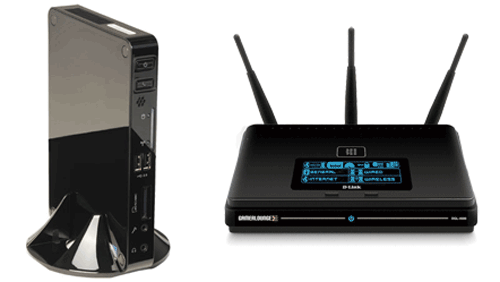
Installing Incredible PBX 4.0. The installation process is simple. Here are the 3 Easy Steps to Free Calling, and The Incredible PBX will be ready to receive and make free U.S./Canada calls immediately:
1. Install PIAF-Purple or PIAF-Brown with FreePBX 2.10 using 32-bit PIAF2 ISO
2. Run Incredible PBX 4 installer
3. Configure Google Voice and a softphone or SIP phone
 Installing PBX in a Flash. Here’s a quick tutorial to get PBX in a Flash 2 installed. To use Incredible PBX 4, just install the latest 32-bit version of PBX in a Flash 2. Unlike other Asterisk aggregations, PBX in a Flash utilizes a two-step install process. The ISO only installs the CentOS 6.2 operating system. Once CentOS is installed, the server reboots and downloads a payload file that includes Asterisk, FreePBX, and many other VoIP and Linux utilities including all of the new Google Voice components. Just choose the PIAF-Purple or PIAF-Brown payload. You’ll then be prompted to choose your flavor of FreePBX. Choose FreePBX 2.10. Then set your time zone and set up a password for FreePBX access, and you’re all set. As part of the install, yum now will automatically update your operating system with the latest updates for CentOS 6.2.
Installing PBX in a Flash. Here’s a quick tutorial to get PBX in a Flash 2 installed. To use Incredible PBX 4, just install the latest 32-bit version of PBX in a Flash 2. Unlike other Asterisk aggregations, PBX in a Flash utilizes a two-step install process. The ISO only installs the CentOS 6.2 operating system. Once CentOS is installed, the server reboots and downloads a payload file that includes Asterisk, FreePBX, and many other VoIP and Linux utilities including all of the new Google Voice components. Just choose the PIAF-Purple or PIAF-Brown payload. You’ll then be prompted to choose your flavor of FreePBX. Choose FreePBX 2.10. Then set your time zone and set up a password for FreePBX access, and you’re all set. As part of the install, yum now will automatically update your operating system with the latest updates for CentOS 6.2.

You can download the 32-bit PIAF2 from SourceForge. Burn the ISO to a CD. Then boot from the installation CD and press the Enter key to begin. If you’ve chosen a machine without an optical drive such as the Atom boxes we recommend, then this Nerd Vittles article will show you how to make a bootable flash drive from the PIAF2 ISO.
WARNING: This install will completely erase, repartition, and reformat EVERY DISK (including USB flash drives) connected to your system so disable any disk you wish to preserve AND remove any USB flash drives! Press Ctrl-C to cancel.
At the time zone prompt, tab once, highlight your time zone, tab to OK and press Enter. At the password prompt, make up a VERY secure root password. Type it twice. Tab to OK, press Enter. Get a cup of coffee. Come back in about 5 minutes. When the system has installed CentOS 6.2, it will reboot. Remove the CD promptly. After the reboot, choose PIAF-Purple or PIAF-Brown. In less than a minute, you’ll be prompted for the FreePBX version you wish to install. Choose FreePBX 2.10 and fill in your choices for the remaining prompts. Then have a 15-minute cup of coffee. After installation is complete, the machine will reboot a second time. You now have a PBX in a Flash base install. On a stand-alone machine, it takes 30-60 minutes. On a virtual machine, it takes about half that time. Log into your server with your root password and write down the server’s IP address. You’ll need it to access FreePBX with your browser. While you’re logged in, issue the following command to make sure your IPtables firewall loads after your network is enabled:
echo "/etc/init.d/iptables restart" >> /etc/rc.d/rc.local
NOTE: For previous users of PBX in a Flash, be aware that this new version automatically runs update-programs, update-fixes, and passwd-master for you. So your system is relatively secure out of the box if you install it behind a hardware-based firewall as we recommend! See the Proxmox cautionary alert in the footnotes to this article!
 Configuring Google Voice. If you plan to use Google Voice, you’ll need a dedicated Google Voice account to support Incredible PBX 4. If you want to use the inbound fax capabilities of Incredible Fax 2, then you’ll need an additional Google Voice line that can be routed to the FAX miscellaneous destination using FreePBX. The more obscure the username (with some embedded numbers), the better off you will be. This will keep folks from bombarding you with unsolicited Gtalk chat messages, and who knows what nefarious scheme will be discovered using Google messaging six months from now. So keep this account a secret!
Configuring Google Voice. If you plan to use Google Voice, you’ll need a dedicated Google Voice account to support Incredible PBX 4. If you want to use the inbound fax capabilities of Incredible Fax 2, then you’ll need an additional Google Voice line that can be routed to the FAX miscellaneous destination using FreePBX. The more obscure the username (with some embedded numbers), the better off you will be. This will keep folks from bombarding you with unsolicited Gtalk chat messages, and who knows what nefarious scheme will be discovered using Google messaging six months from now. So keep this account a secret!
We’ve tested this extensively using an existing Gmail account, and inbound calling is just not reliable. The reason seems to be that Google always chooses Gmail chat as the inbound call destination if there are multiple registrations from the same IP address. So, be reasonable. Do it our way! Set up a dedicated Gmail and Google Voice account, and use it exclusively with Incredible PBX 4. It’s free at least through 2013. Google Voice no longer is by invitation only so, if you’re in the U.S. or have a friend that is, head over to the Google Voice site and register. If you’re living on another continent, see MisterQ’s posting for some setup tips.
You must choose a telephone number (aka DID) for your new account, or Google Voice calling will not work… in either direction. Google used to permit outbound Gtalk calls using a fake CallerID, but that obviously led to abuse so it’s over! You also have to tie your Google Voice account to at least one working phone number as part of the initial setup process. Your cellphone number will work just fine. Don’t skip this step either. Just enter the provided 2-digit confirmation code when you tell Google to place the test call to the phone number you entered. Once the number is registered, you can disable it if you’d like in Settings, Voice Setting, Phones. But…
IMPORTANT: Be sure to enable the Google Chat option as one of your phone destinations in Settings, Voice Setting, Phones. That’s the destination we need for The Incredible PBX to work its magic! Otherwise, all inbound and outbound calls will fail. If you don’t see this option, you may need to call up Gmail and enable Google Chat there first. Then go back to the Google Voice Settings.
While you’re still in Google Voice Settings, click on the Calls tab. Make sure your settings match these:
- Call Screening – OFF
- Call Presentation – OFF
- Caller ID (In) – Display Caller’s Number
- Caller ID (Out) – Don’t Change Anything
- Do Not Disturb – OFF
- Call Options (Enable Recording) – OFF
- Global Spam Filtering – ON
Click Save Changes once you adjust your settings. Under the Voicemail tab, plug in your email address so you get notified of new voicemails. Down the road, receipt of a Google Voice voicemail will be a big hint that something has come unglued on your PBX.
Incredible PBX 4.0 Installation. Log into your server as root and issue the following commands to run The Incredible PBX 4 installer:
cd /root
wget http://incrediblepbx.com/incrediblepbx4.x
chmod +x incrediblepbx4.x
./incrediblepbx4.x
UPDATE: There are some new releases. Incredible PBX 10 supports 64-bit PIAF-Purple with Asterisk 1.8 and FreePBX 2.10. There also are prebuilt appliances for Amazon EC2 and VirtualBox. Incredible PBX 11 supports 32-bit PIAF-Green with Asterisk 11 and FreePBX 2.11. There also are prebuilt appliances for VirtualBox and VMware. Both Incredible PBX 10 and Incredible PBX 11 support Incredible Fax as well.
When The Incredible PBX install begins, you’ll be prompted for your FreePBX maint password. This is required to properly configure CallerID Superfecta for you. Your credentials never leave your server!
Now have another 15-minute cup of coffee. While you’re waiting just make sure that you’ve heeded our advice and installed your server behind a hardware-based firewall. No ports need to be opened on your firewall to support Incredible PBX. Leave it that way!
One final word of caution is in order regardless of your choice of providers: Do NOT use special characters in any provider passwords, or nothing will work!
FINAL STEPS. Once the Incredible PBX install completes, there are two optional steps for those that will have remote phones or users outside your firewall. Install both Travelin’ Man 2 and 3 for an ultra-secure system. Also be sure to run update-fixes before restarting your machine!
Logging in to FreePBX 2.10. Using a web browser, you access the FreePBX GUI by pointing your browser to the IP address of your Incredible PBX. Click on the Users tab. It will change to Admin. Now click the FreePBX button. When prompted for a username, it’s maint. When prompted for the password, it’s whatever you set up as your maint password when you installed Incredible PBX 4. If you forget it, you can always reset it by logging into your server as root and running passwd-master.
Configuring Google Voice Trunks in FreePBX. All trunk configurations now are managed within FreePBX, including Google Voice. This makes it easy to customize your Incredible PBX to meet your specific needs. If you plan to use Google Voice, here’s how to quickly configure one or more Google Voice trunks within FreePBX. After logging into FreePBX with your browser, click the Other tab and choose Google Voice. To Add a new Google Voice account, just fill out the form:

Phone number is your 10-digit Google Voice number. Username is your Google Voice account name without @gmail.com. Password is your Google Voice password. NOTE: Don’t use 2-stage password protection in this Google Voice account! Be sure to check all three boxes: Add trunk, Add routes, and Agree to TOS. Then click Submit Changes and reload FreePBX. You can add additional Google Voice numbers by clicking Add GoogleVoice Account option in the right margin and repeating the drill.
While you’re still in FreePBX, choose Setup, Extensions, and click on the 701 extension. Write down your extension password which you’ll need to configure a phone in a minute.
IMPORTANT LAST STEP: Google Voice will not work unless you restart Asterisk from the Linux command line at this juncture. Using SSH, log into your server as root and issue the following command: amportal restart. You’ll note that Incredible PBX 4 now automatically enables the Asterisk Gtalk and Jabber modules for you once you create a Google Voice account.
Incredible Fax 2 Installation. If you want the added convenience of having your Incredible PBX double as a free fax machine, run install-incredfax2 after the Incredible PBX 4 install completes. Plug in your email address for delivery of incoming faxes and enter your home area code when prompted. For every other prompt, just press the Enter key. If you’d like to also add the optional OCR utility, just choose it when prompted. For complete documentation, see this Nerd Vittles article. Don’t forget that a REBOOT OF YOUR SERVER is requiredwhen the install is finished, or faxing won’t work! Then log in through the PIAF GUI using maint:password. Be sure to change your password!
Also be sure to set up a second, dedicated Google Voice number if you want support for inbound faxing. Once the Google Voice credentials are configured in FreePBX for the additional Google Voice line, simply add an Inbound Route for this DID to point to the fax destination. This comes preconfigured with Incredible PBX 4. Just plug in your 10-digit Google Voice number and other entries shown in the form below. Save your entries and reload FreePBX.
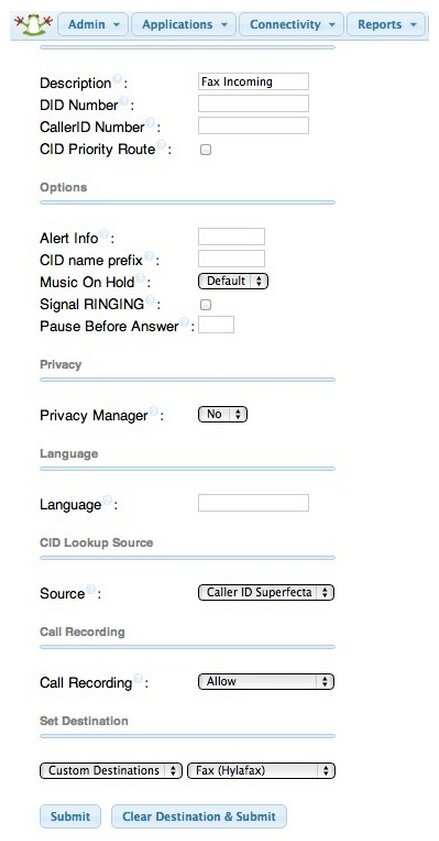
Extension Password Discovery. If you’re too lazy to look up your extension 701 password using the FreePBX GUI, you can log into your server as root and issue the following command to obtain the password for extension 701 which we’ll need to configure your softphone or color videophone in the next step:
mysql -uroot -ppassw0rd -e "select id,data from asterisk.sip where id='701' and keyword='secret'"
The result will look something like the following where 701 is the extension and 18016 is the randomly-generated extension password exclusively for your Incredible PBX:
+—–+——-+
id data
+—–+——-+
701 18016
+—–+——-+
 Configuring a SIP Phone. There are hundreds of terrific SIP telephones and softphones for Asterisk-based systems. Once you get things humming along, you’ll want a real SIP telephone such as the $50 Nortel color videophone we’ve recommended above. You’ll also find lots of additional recommendations on Nerd Vittles and in the PBX in a Flash Forum. If you’re like us, we want to make damn sure this stuff works before you shell out any money. So, for today, let’s download a terrific (free) softphone to get you started. We recommend X-Lite because there are versions for Windows, Mac, and Linux. So download your favorite from this link. Install and run X-Lite on your Desktop. At the top of the phone, click on the Down Arrow and choose SIP Account Settings, Add. Enter the following information using your actual password for extension 701 and the actual IP address of your Incredible PBX server instead of 192.168.0.251. Click OK when finished. Your softphone should now show: Available.
Configuring a SIP Phone. There are hundreds of terrific SIP telephones and softphones for Asterisk-based systems. Once you get things humming along, you’ll want a real SIP telephone such as the $50 Nortel color videophone we’ve recommended above. You’ll also find lots of additional recommendations on Nerd Vittles and in the PBX in a Flash Forum. If you’re like us, we want to make damn sure this stuff works before you shell out any money. So, for today, let’s download a terrific (free) softphone to get you started. We recommend X-Lite because there are versions for Windows, Mac, and Linux. So download your favorite from this link. Install and run X-Lite on your Desktop. At the top of the phone, click on the Down Arrow and choose SIP Account Settings, Add. Enter the following information using your actual password for extension 701 and the actual IP address of your Incredible PBX server instead of 192.168.0.251. Click OK when finished. Your softphone should now show: Available.
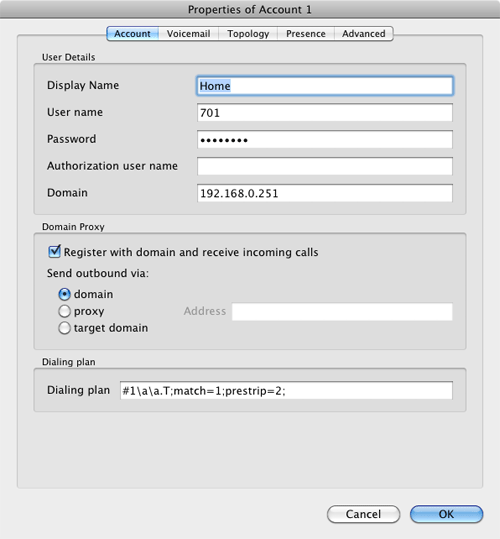
 Incredible PBX Test Flight. The proof is in the pudding as they say. So let’s try two simple tests. First, let’s place an outbound call. Using the softphone, dial your 10-digit cellphone number. Google Voice should transparently connect you. Answer the call and make sure you can send and receive voice on both phones. Second, from another phone, call the Google Voice number that you’ve dedicated to The Incredible PBX. Your softphone should begin ringing shortly. Answer the call, press 1 to accept the call, and then make sure you can send and receive voice on both phones. Hang up. If everything is working, congratulations!
Incredible PBX Test Flight. The proof is in the pudding as they say. So let’s try two simple tests. First, let’s place an outbound call. Using the softphone, dial your 10-digit cellphone number. Google Voice should transparently connect you. Answer the call and make sure you can send and receive voice on both phones. Second, from another phone, call the Google Voice number that you’ve dedicated to The Incredible PBX. Your softphone should begin ringing shortly. Answer the call, press 1 to accept the call, and then make sure you can send and receive voice on both phones. Hang up. If everything is working, congratulations!
Here’s a brief video demonstration showing how to set up a softphone to use with your Incredible PBX, and it also walks you through several of the more than 50 Asterisk applications included in your system.
Learn First. Explore Second. Even though the installation process has been completed, we strongly recommend you do some reading before you begin your VoIP adventure. VoIP PBX systems have become a favorite target of the hackers and crackers around the world and, unless you have an unlimited bank account, you need to take some time learning where the minefields are in today’s VoIP world. Start by reading our Primer on Asterisk Security. We’ve secured all of your passwords except your root password and your passwd-master password. We’re assuming you’ve put very secure passwords on those accounts as if your phone bill depended upon it. It does! There’s loads of additional documentation on the PBX in a Flash documentation web site.
 Solving One-Way Audio Problems. If you experience one-way audio on some of your phone calls, you may need to adjust your Asterisk SIP settings. These now can be tweaked within FreePBX by choosing Settings, Asterisk SIP Settings. Just plug in your public IP address and replace 192.168.0.0 with the subnet address of your private network. Save settings and reload FreePBX.
Solving One-Way Audio Problems. If you experience one-way audio on some of your phone calls, you may need to adjust your Asterisk SIP settings. These now can be tweaked within FreePBX by choosing Settings, Asterisk SIP Settings. Just plug in your public IP address and replace 192.168.0.0 with the subnet address of your private network. Save settings and reload FreePBX.

 Choosing VoIP Providers. Nothing beats free when it comes to long distance calls. But nothing lasts forever. And, in the VoIP World, redundancy is dirt cheap. So we strongly recommend you set up another account with Vitelity using our special link below. This gives your PBX a secondary way to communicate with every telephone in the world, and it also gets you a second real phone number for your new system… so that people can call you. Here’s how it works. You pay Vitelity a deposit for phone service. They then will bill you $3.99 a month for your new phone number. This $3.99 also covers the cost of unlimited inbound calls (two at a time) delivered to your PBX for the month. For outbound calls, you pay by the minute and the cost is determined by where you’re calling. If you’re in the U.S., outbound calls to anywhere in the U.S. are a little over a penny a minute. If you change your mind about Vitelity and want a refund of the balance in your account, all you have to do is ask. The trunks for Vitelity already are preconfigured with The Incredible PBX. Just insert your credentials using FreePBX and uncheck the Disable Trunk checkbox. Then add the Vitelity trunk as the third destination for your default outbound route. That’s it. Congratulations! You now have a totally redundant phone system.
Choosing VoIP Providers. Nothing beats free when it comes to long distance calls. But nothing lasts forever. And, in the VoIP World, redundancy is dirt cheap. So we strongly recommend you set up another account with Vitelity using our special link below. This gives your PBX a secondary way to communicate with every telephone in the world, and it also gets you a second real phone number for your new system… so that people can call you. Here’s how it works. You pay Vitelity a deposit for phone service. They then will bill you $3.99 a month for your new phone number. This $3.99 also covers the cost of unlimited inbound calls (two at a time) delivered to your PBX for the month. For outbound calls, you pay by the minute and the cost is determined by where you’re calling. If you’re in the U.S., outbound calls to anywhere in the U.S. are a little over a penny a minute. If you change your mind about Vitelity and want a refund of the balance in your account, all you have to do is ask. The trunks for Vitelity already are preconfigured with The Incredible PBX. Just insert your credentials using FreePBX and uncheck the Disable Trunk checkbox. Then add the Vitelity trunk as the third destination for your default outbound route. That’s it. Congratulations! You now have a totally redundant phone system.
Incredible PBX includes preconfigured trunk setups for all of your favorite trunk providers. Just plug in your credentials and activate the trunks you need. In less than a minute, you’re done. Here’s the Incredible PBX Top 20 Trunk List with some reasons why these providers made our short list:
- AxVoice ($14.99/mo. Business Plan; $16.58/mo. Unlimited Calls to 45 Countries)
- CallCentric (Good International Calling Rates)
- DIDforSale (20 channels per DID; unlimited DID calls for $8.99/mo.)
- ENUM
- FlowRoute (Good International Calling Rates)
- FreeNum
- Future-Nine (Supports CallerID Spoofing)
- Google Voice (Free DIDs and free U.S./Canada calling)
- IPkall (Free SIP/IAX DIDs)
- Les.net (Supports CallerID Spoofing; very low rates)
- LocalPhone (Dirt-cheap DIDs and calling rates worldwide; Free iNum DID)
- Simon Telephonics (Free SIP-to-GoogleVoice Gateway)
- SIPgate (Free residential DIDs sometimes)
- Skype (Free Skype-to-Skype calls worldwide)
- Teliax (Unlimited inbound DID $5/mo.)
- Vitelity (Our supporter and the Best in the Business!)
- VoIPms (CallerID spoofing; Free iNum calling; Very low rates)
- VoIPMyWay (Residential Unlimited: $15.50/mo. Business Unlimited: $40/mo.)
- VoIPStreet (Free DID)
Stealth AutoAttendant. When incoming calls arrive, the caller is greeted with a welcoming message from Allison which says something like "Thanks for calling. Please hold a moment while I locate someone to take your call." To the caller, it’s merely a greeting. To those "in the know," it’s actually an AutoAttendant (aka IVR system) that gives you the opportunity to press a button during the message to trigger the running of some application on your Incredible PBX. As configured, the only option that works is 0 which fires up the Nerd Vittles Apps IVR. It’s quite easy to add additional features such as voicemail retrieval or DISA for outbound calling. Just edit the MainIVR option in FreePBX under Setup, IVR. Keep in mind that anyone (anywhere in the world) can choose these options. So be extremely careful not to expose your system to security vulnerabilities by making certain that any options you add have very secure passwords! It’s your phone bill. 😉
Configuring Email. You’re going to want to be notified when updates are available for FreePBX, and you may also want notifications when new voicemails arrive. Everything already is set up for you except actually entering your email notification address. Using a web browser, open the FreePBX GUI by pointing your browser to the IP address of your Incredible PBX. Then click Administration and choose FreePBX. To set your email address for FreePBX updates, go to Settings, General Settings and scroll to the bottom of the screen. To configure emails to notify you of incoming voicemails, go to Applications, Extensions, 701 and scroll to the bottom of the screen. Then follow your nose. Be sure to reload FreePBX when prompted after saving your changes.
A Final Word About Security. In case you couldn’t tell, security matters to us, and it should matter to you. Not only is the safety of your system at stake but also your wallet and the safety of other folks’ systems. Our only means of contacting you with security updates is through the RSS Feed that we maintain for the PBX in a Flash project. This feed is prominently displayed in the web GUI which you can access with any browser pointed to the IP address of your server. Check It Daily! Or add our RSS Feed to your favorite RSS Reader. We also recommend you follow @NerdUno on Twitter. We’ll keep you entertained and provide immediate notification of security problems that we hear about. Finally, visit the PIAF Forums regularly. You’ll be surprised what you can learn in 10 minutes of browsing. Be safe!
Kicking the Tires. OK. That’s enough tutorial for today. Let’s play. Using your new softphone, begin your adventure by dialing these extensions:
- D-E-M-O – Incredible PBX Demo (running on your PBX)
- 1234*1061 – Nerd Vittles Demo via ISN FreeNum connection to NV
- Z-I-P – Enter a five digit zip code for any U.S. weather report
- 6-1-1 – Enter a 3-character airport code for any U.S. weather report
- 5-1-1 – Get the latest news and sports headlines from Yahoo News
- T-I-D-E – Get today’s tides and lunar schedule for any U.S. port
- F-A-X – Send a fax to an email address of your choice
- 4-1-2 – Phonebook lookup/dialer with AsteriDex
- M-A-I-L – Record a message and deliver it to any email address
- C-O-N-F – Set up a MeetMe Conference on the fly
- 1-2-3 – Schedule regular/recurring reminder (PW: 12345678)
- 2-2-2 – ODBC/Timeclock Lookup Demo (Empl No: 12345)
- 2-2-3 – ODBC/AsteriDex Lookup Demo (Code: AME)
- 3-3-3 – Look up a definition for any word or term
- 9-4-9 – Weather forecast for any city in the world
- 9-5-0 – Retrieve stock report by stock symbol
- 9-5-1 – Latest Google News headlines
- Dial *68 – Schedule a hotel-style wakeup call from any extension
- 1-204-666-1001 – PIAF Support Conference Bridge (Conf#: 1091881)
- 882*1061 – VoIP Users Conference every Friday at Noon (EST)

PBX in a Flash SQLite Registry. We want to introduce you to the PBX in a Flash Registry which uses SQLite, a zero-configuration SQL-compatible database engine. After logging into your server as root, just type show-registry for a listing of all of the applications, versions, and install dates of everything on your new server. Choosing the A option will generate registry.txt in the /root folder while the other options will let you review the applications by category on the screen. For example, the G option displays all of The Incredible PBX add-ons that have been installed. Here’s the complete list of options:
- A – Write the contents of the registry to registry.txt
- B – PBX in a Flash install details
- C – Extra programs install details
- D – Update-fixes status and details
- E – RPM install details
- F – FreePBX modules install details
- G – Incredible PBX install details
- Q – Quit this program
And here’s a sample from an install we recently completed.
 Special Thanks. It’s hard to know where to start in expressing our gratitude for all of the participants that made today’s incredibly simple-to-use product possible. To Philippe Sultan and the rest of the Asterisk development team, thank you for making Jabber jabber with Asterisk. Wish you were still involved! To Leif Madsen, thanks for your pioneering work with Gtalk and Jabber which got this ball rolling. To Philippe Lindheimer, Tony Lewis, and the rest of the FreePBX development team, thanks for FreePBX 2.10 which really makes Asterisk shine. To Lefteris Zafiris, thank you for making Flite and all of the Google TTS and STT utilities work with Asterisk 1.8 thereby preserving all of the Nerd Vittles text-to-speech applications while allowing us to add dozens of new ones. To Darren Sessions, thanks for whipping app_swift into shape and restoring Cepstral and commercial TTS applications to the land of the living. The new all-in-one installer is awesome. To all of our pals in the PBX Open Source Software Alliance (POSSA) that develop and maintain some our favorite Asterisk apps, you’re unbelievable! To Andrew Nagy, thanks for all you do and especially for keeping Google Voice humming along in FreePBX. And to our pal, Tom King, we couldn’t have done it without you. You rolled up your sleeves and really made CentOS 6.2 and Asterisk 1.8 sit up and bark. No one will quite understand what an endeavor that is until they try it themselves. CentOS 6 implementations of Asterisk are few and far between, and Tom has made it look incredibly easy. It wasn’t! And, last but not least, to all of our pioneers and beta testers who spent their Independence Day and many other days testing this new release, THANK YOU!
Special Thanks. It’s hard to know where to start in expressing our gratitude for all of the participants that made today’s incredibly simple-to-use product possible. To Philippe Sultan and the rest of the Asterisk development team, thank you for making Jabber jabber with Asterisk. Wish you were still involved! To Leif Madsen, thanks for your pioneering work with Gtalk and Jabber which got this ball rolling. To Philippe Lindheimer, Tony Lewis, and the rest of the FreePBX development team, thanks for FreePBX 2.10 which really makes Asterisk shine. To Lefteris Zafiris, thank you for making Flite and all of the Google TTS and STT utilities work with Asterisk 1.8 thereby preserving all of the Nerd Vittles text-to-speech applications while allowing us to add dozens of new ones. To Darren Sessions, thanks for whipping app_swift into shape and restoring Cepstral and commercial TTS applications to the land of the living. The new all-in-one installer is awesome. To all of our pals in the PBX Open Source Software Alliance (POSSA) that develop and maintain some our favorite Asterisk apps, you’re unbelievable! To Andrew Nagy, thanks for all you do and especially for keeping Google Voice humming along in FreePBX. And to our pal, Tom King, we couldn’t have done it without you. You rolled up your sleeves and really made CentOS 6.2 and Asterisk 1.8 sit up and bark. No one will quite understand what an endeavor that is until they try it themselves. CentOS 6 implementations of Asterisk are few and far between, and Tom has made it look incredibly easy. It wasn’t! And, last but not least, to all of our pioneers and beta testers who spent their Independence Day and many other days testing this new release, THANK YOU!
 Don’t forget to List Yourself in Directory Assistance so everyone can find you by dialing 411. And add your new number to the Do Not Call Registry to block telemarketing calls. Or just call 888-382-1222 from your new number. Enjoy!
Don’t forget to List Yourself in Directory Assistance so everyone can find you by dialing 411. And add your new number to the Do Not Call Registry to block telemarketing calls. Or just call 888-382-1222 from your new number. Enjoy!
Originally published: Monday, July 9, 2012
 Support Issues. With any application as sophisticated as this one, you’re bound to have questions. Blog comments are a terrible place to handle support issues although we welcome general comments about our articles and software. If you have particular support issues, we encourage you to get actively involved in the PBX in a Flash Forums. It’s the best Asterisk tech support site in the business, and it’s all free! In fact, there is a thread dedicated to support of Incredible PBX 4.0. Please have a look and post your support questions there. Unlike some forums, ours is extremely friendly and is supported by literally hundreds of Asterisk gurus and thousands of ordinary users just like you. You won’t have to wait long for an answer to your question.
Support Issues. With any application as sophisticated as this one, you’re bound to have questions. Blog comments are a terrible place to handle support issues although we welcome general comments about our articles and software. If you have particular support issues, we encourage you to get actively involved in the PBX in a Flash Forums. It’s the best Asterisk tech support site in the business, and it’s all free! In fact, there is a thread dedicated to support of Incredible PBX 4.0. Please have a look and post your support questions there. Unlike some forums, ours is extremely friendly and is supported by literally hundreds of Asterisk gurus and thousands of ordinary users just like you. You won’t have to wait long for an answer to your question.
Weather Alert. If you’re already using the Nerd Vittles Weather Applications including Weather by ZIP Code and Weather by Airport Code, you may have noticed that the National Weather Service "improved" things over the Fourth of July holiday. Consequently, neither app worked any longer. The fixes now have been posted on the PIAF Forum and can be downloaded at your convenience. Incredible PBX 4.0 already includes the updates.

Astricon 2012. Astricon 2012 will be in Atlanta at the Sheraton beginning October 23 through October 25. We hope to see many of you there. We called Atlanta home for over 25 years so we’d love to show you around. Be sure to tug on my sleeve and mention you’d like a free PIAF Thumb Drive. We’ll have a bunch of them to pass out to our loyal supporters. Nerd Vittles readers also can save 20% on your registration by using coupon code: AC12VIT.


Need help with Asterisk? Visit the PBX in a Flash Forum.
Or Try the New, Free PBX in a Flash Conference Bridge.
whos.amung.us If you’re wondering what your fellow man is reading on Nerd Vittles these days, wonder no more. Visit our new whos.amung.us statistical web site and check out what’s happening. It’s a terrific resource both for us and for you.
Special Thanks to Our Generous Sponsors
FULL DISCLOSURE: ClearlyIP, Skyetel, Vitelity, DigitalOcean, Vultr, VoIP.ms, 3CX, Sangoma, TelecomsXchange and VitalPBX have provided financial support to Nerd Vittles and our open source projects through advertising, referral revenue, and/or merchandise. As an Amazon Associate and Best Buy Affiliate, we also earn from qualifying purchases. We’ve chosen these providers not the other way around. Our decisions are based upon their corporate reputation and the quality of their offerings and pricing. Our recommendations regarding technology are reached without regard to financial compensation except in situations in which comparable products at comparable pricing are available from multiple sources. In this limited case, we support our sponsors because our sponsors support us.
 BOGO Bonaza: Enjoy state-of-the-art VoIP service with a $10 credit and half-price SIP service on up to $500 of Skyetel trunking with free number porting when you fund your Skyetel account. No limits on number of simultaneous calls. Quadruple data center redundancy. $25 monthly minimum spend required. Tutorial and sign up details are here.
BOGO Bonaza: Enjoy state-of-the-art VoIP service with a $10 credit and half-price SIP service on up to $500 of Skyetel trunking with free number porting when you fund your Skyetel account. No limits on number of simultaneous calls. Quadruple data center redundancy. $25 monthly minimum spend required. Tutorial and sign up details are here.
 The lynchpin of Incredible PBX 2020 and beyond is ClearlyIP components which bring management of FreePBX modules and SIP phone integration to a level never before available with any other Asterisk distribution. And now you can configure and reconfigure your new Incredible PBX phones from the convenience of the Incredible PBX GUI.
The lynchpin of Incredible PBX 2020 and beyond is ClearlyIP components which bring management of FreePBX modules and SIP phone integration to a level never before available with any other Asterisk distribution. And now you can configure and reconfigure your new Incredible PBX phones from the convenience of the Incredible PBX GUI.
 VitalPBX is perhaps the fastest-growing PBX offering based upon Asterisk with an installed presence in more than 100 countries worldwide. VitalPBX has generously provided a customized White Label version of Incredible PBX tailored for use with all Incredible PBX and VitalPBX custom applications. Follow this link for a free test drive!
VitalPBX is perhaps the fastest-growing PBX offering based upon Asterisk with an installed presence in more than 100 countries worldwide. VitalPBX has generously provided a customized White Label version of Incredible PBX tailored for use with all Incredible PBX and VitalPBX custom applications. Follow this link for a free test drive!
 Special Thanks to Vitelity. Vitelity is now Voyant Communications and has halted new registrations for the time being. Our special thanks to Vitelity for their unwavering financial support over many years and to the many Nerd Vittles readers who continue to enjoy the benefits of their service offerings. We will keep everyone posted on further developments.
Special Thanks to Vitelity. Vitelity is now Voyant Communications and has halted new registrations for the time being. Our special thanks to Vitelity for their unwavering financial support over many years and to the many Nerd Vittles readers who continue to enjoy the benefits of their service offerings. We will keep everyone posted on further developments.
Some Recent Nerd Vittles Articles of Interest…
SMS Dictator 2.0: Send SMS Messages Using Your Phonebook with Google Voice

Here’s an update of a terrific Google™ speech-to-text application for your Asterisk® goody bag. SMS Dictator 2.0 lets you pick up any phone on your Asterisk system, dictate a brief message, have it transcribed by Google, and then delivered as an SMS text message by entering either a 10-digit number of your choosing or by saying any name in your AsteriDex phonebook. The installation process on PBX in a Flash™ systems takes only a minute. And you’ll find Asterisk SMS Messaging to be a welcome addition to your VoIP Swiss Army Knife.
Prerequisites. For the installer to work seamlessly, you’ll need a PBX in a Flash 2 server with the PERL gvoice CLI tool. You can test whether this is working by logging into your server as root and issuing the command: gvoice. When prompted for your Google Voice account name, enter it and include @gmail.com. Then enter your password. If you get a gvoice prompt, all is well. Type quit to exit. If you get errors or the gvoice app doesn’t exist, click on the pygooglevoice link in this paragraph to get things squared away.
You’ll also need a Google Voice™ account that can be used to send the SMS messages. Today’s SMS installer will prompt you for your Google Voice account name in the format: myname@gmail.com. Then you’ll be prompted for your Google Voice password. Once you’ve entered your credentials, the rest is automagic. With a little manual tweaking of the installation script, you can get this working on any Asterisk-based server running under Linux.
As configured, SMS Dictator™ uses extension 767 (S-M-S) to generate SMS messages. If this conflicts with an extension on your server, you can edit the extensions_custom.conf dialplan in /etc/asterisk.
Legal Disclaimer. What we’re demonstrating today is how to use a publicly accessible web resource to respond to dictation requests generated by a phone connected to your Asterisk server. We’re assuming that Google has its legal bases covered and has a right to provide the public service they are offering. We are not vouching for Google or the services being offered in any way. By using our tutorial, YOU AGREE TO ASSUME ALL RISKS, LEGAL AND OTHERWISE, ASSOCIATED WITH USE OF THIS FREELY ACCESSIBLE WEB TOOL. NO WARRANTY EXPRESS OR IMPLIED IS BEING PROVIDED BY US INCLUDING ANY IMPLIED WARRANTY OF FITNESS FOR USE OR MERCHANTABILITY. You, of course, have an absolute right not to read our articles or implement our code if you have reservations of any kind or are unwilling to assume all risks associated with such use. Sorry for legalese, but it’s the time in which we live I’m afraid. Plain English: "Don’t Shoot the Messenger!"
Removing Previous SMS Dictator Code. If you installed our earlier version of SMS Dictator, then you have a little housekeeping to do before we begin. Log into your server as root and change to the /etc/asterisk directory. Then edit extensions_custom.conf. Search through the file until you find the lines beginning with exten => 767. Delete all of those lines. If you’re using nano, Ctrl-K will delete a line at a time. Once you’ve deleted all the 767 lines, save the file: Ctrl-X, Y, and press Enter. Now continue on…
Installation. To install SMS Dictator, log into your PBX in a Flash server as root and issue the following commands:
cd /root
wget http://nerdvittles.com/sms-dictator.tgz
tar zxvf sms-dictator.tgz
./sms-dictator.sh
Accept the license agreement and fill in your Google Voice credentials when prompted. In under a minute, you’ll be ready to test things out.
Taking SMS Dictator for a Spin. Now you’re ready to try it. Pick up any phone connected to your Asterisk server. Dial S-M-S (767). When prompted, dictate a brief message and press #. If the transcription played back is correct, press 1. Or hang up and try again. Now press 1 to enter a 10-digit phone number for the SMS recipient or press 2 to speak the name of someone in your AsteriDex database. When prompted, enter the 10-digit number or say the name of the SMS recipient. If the response read back to you is correct, press 1 to send the SMS message. It’s as simple as that.
AsteriDex Integration. If you’re using AsteriDex for your contacts, then it’s pretty simple to look up SMS contact numbers from there instead of having to remember them and manually key them in. The only trick is that you may need to adjust the names slightly if Google has difficulty understanding what you’re saying. For example, Google does not like Ward but is perfectly happy with Uncle Wardy. So are we. Here’s a hint. Multi-syllable words fare better than 3 and 4 letter words.
SMS Message Blasting. The SMS messaging possibilities, of course, are endless. A lively discussion is was underway on the PIAF Forum until The Great Trainwreck of 2013. This could include notifications to Little League teams about schedule changes, or alerts from a school about emergencies, or community alerts about tornados. You can probably think up a dozen more on your own. We’ve now released the first preview of a message blasting utility which you are welcome to download here. Enjoy!
3/2/2017 Update: A patched version of pygooglevoice to support SMS messaging is now available here.
Originally published: Monday, August 13, 2012

Need help with Asterisk? Visit the NEW PBX in a Flash Forum.
whos.amung.us If you’re wondering what your fellow man is reading on Nerd Vittles these days, wonder no more. Visit our new whos.amung.us statistical web site and check out what’s happening. It’s a terrific resource both for us and for you.
Special Thanks to Our Generous Sponsors
FULL DISCLOSURE: ClearlyIP, Skyetel, Vitelity, DigitalOcean, Vultr, VoIP.ms, 3CX, Sangoma, TelecomsXchange and VitalPBX have provided financial support to Nerd Vittles and our open source projects through advertising, referral revenue, and/or merchandise. As an Amazon Associate and Best Buy Affiliate, we also earn from qualifying purchases. We’ve chosen these providers not the other way around. Our decisions are based upon their corporate reputation and the quality of their offerings and pricing. Our recommendations regarding technology are reached without regard to financial compensation except in situations in which comparable products at comparable pricing are available from multiple sources. In this limited case, we support our sponsors because our sponsors support us.
 BOGO Bonaza: Enjoy state-of-the-art VoIP service with a $10 credit and half-price SIP service on up to $500 of Skyetel trunking with free number porting when you fund your Skyetel account. No limits on number of simultaneous calls. Quadruple data center redundancy. $25 monthly minimum spend required. Tutorial and sign up details are here.
BOGO Bonaza: Enjoy state-of-the-art VoIP service with a $10 credit and half-price SIP service on up to $500 of Skyetel trunking with free number porting when you fund your Skyetel account. No limits on number of simultaneous calls. Quadruple data center redundancy. $25 monthly minimum spend required. Tutorial and sign up details are here.
 The lynchpin of Incredible PBX 2020 and beyond is ClearlyIP components which bring management of FreePBX modules and SIP phone integration to a level never before available with any other Asterisk distribution. And now you can configure and reconfigure your new Incredible PBX phones from the convenience of the Incredible PBX GUI.
The lynchpin of Incredible PBX 2020 and beyond is ClearlyIP components which bring management of FreePBX modules and SIP phone integration to a level never before available with any other Asterisk distribution. And now you can configure and reconfigure your new Incredible PBX phones from the convenience of the Incredible PBX GUI.
 VitalPBX is perhaps the fastest-growing PBX offering based upon Asterisk with an installed presence in more than 100 countries worldwide. VitalPBX has generously provided a customized White Label version of Incredible PBX tailored for use with all Incredible PBX and VitalPBX custom applications. Follow this link for a free test drive!
VitalPBX is perhaps the fastest-growing PBX offering based upon Asterisk with an installed presence in more than 100 countries worldwide. VitalPBX has generously provided a customized White Label version of Incredible PBX tailored for use with all Incredible PBX and VitalPBX custom applications. Follow this link for a free test drive!
 Special Thanks to Vitelity. Vitelity is now Voyant Communications and has halted new registrations for the time being. Our special thanks to Vitelity for their unwavering financial support over many years and to the many Nerd Vittles readers who continue to enjoy the benefits of their service offerings. We will keep everyone posted on further developments.
Special Thanks to Vitelity. Vitelity is now Voyant Communications and has halted new registrations for the time being. Our special thanks to Vitelity for their unwavering financial support over many years and to the many Nerd Vittles readers who continue to enjoy the benefits of their service offerings. We will keep everyone posted on further developments.
Some Recent Nerd Vittles Articles of Interest…
Google Nexus 7 Review: State-of-the-Art Features, Performance & Price
What a difference a Jelly Bean can make! Home runs don’t come easy in the technology arena especially in the tablet market with a third-generation, 800-pound gorilla named iPad® already sitting in the room and an upstart Kindle Fire® threatening to burn the house down. But, if you’ve been disappointed by the fit and finish of previous Android releases, then it’s time to have another look. Whether you’re a road warrior or a couch potato, you’re gonna love the new Nexus 7 quad-core tablet from Asus. Open the case and look into your Nexus 7’s eyes. Blink once1 and boom. Your desktop appears. Incredible features. Stunning performance. And unbelievable price.

We like to start with the bad news. There’s not much: no rear-facing camera, no microSD expansion slot, and no HDMI port. Don’t make the mistake of buying the 8GB tablet. While $199 is appealing, you’ll quickly wish you’d spent the additional $50 to purchase the 16GB flavor. Remember, the storage is not expandable. But, if you hurry, you’ll get a $25 gift card to Google Play. So go for broke and splurge. You’ll want to fill all 16 gigs with lightening fast Android apps. And there’s no longer a shortage of choices. Almost anything that you’d find on an iPad is available for the Nexus 7… and then some. The one missing feature in Jelly Bean is Flash support. That’s Adobe’s doing, not Google’s. But there’s an easy fix. Load the Firefox Beta browser and side load the Adobe Flash Play 11.1 apk, and you’re back in business.
If you follow our musings on Nerd Vittles, you know that we eat our own dog food. So our Nexus 7 has both a PPTP VPN and NeoRouter VPN activated. We connect back to our PBX in a Flash server through one of the VPN connections and log in as an extension on the home Asterisk® server using Bria for Android. We activate a Google Voice account using GrooVe IP. And we connect back to an OBi device in the home office using OBiON. That makes three active phones for inbound and outbound calls right on the Nexus 7 desktop. Incoming calls to our home office pop up using Gtalk with the new Nerd Vittles’ GV Call Notifier.
As you can see from the above screenshot (actual screen size), our most recent Gmail messages, Google Calendar, and today’s weather forecast for our current location are displayed whenever the tablet is opened for use. The PIAF Forums are one click away with Tapatalk as is access to your favorite dozen apps and 20,000 of your favorite songs.
Drooling for Apple’s Siri? You’ll love the new, voice-activated Google Search which puts Siri to shame. Watch the video above and decide for yourself. And then there’s Google Now:
It tells you today’s weather before you start your day, how much traffic to expect before you leave for work, when the next train will arrive as you’re standing on the platform, or your favorite team’s score while they’re playing. And the best part? All of this happens automatically. Cards appear throughout the day at the moment you need them.
The Nexus 7 also sports a gyroscope, accelerometer, magnetometer, NFC, Bluetooth 4.0, and a GPS chip that can take advantage of Google Maps new off-line mode when WiFi isn’t available. Want to take a high-res screenshot? Just hold down the Power and Vol/Down buttons at the same time, and presto, your screenshot is saved. Video conferencing also is a breeze using either Google Talk or Skype. File transfers are equally easy thanks to NFC. Just tap two Jelly Bean devices together and the file transfer is on its way wirelessly. And then there’s Google Wallet which lets you pay for purchases with the tap of your Nexus 7. In a revolutionary move, there’s also a well-written, real User’s Guide (as in book) at your fingertips. Just click the Book icon to access your entire book collection including the User’s Guide. We could go on, but you get the idea. It’s revolutionary as is the price!

We can’t really show the near instantaneous response that a quad-core processor provides. Suffice it to say, this isn’t a Kindle Fire brimming with compromises to save on production costs. It’s a fast, no-compromise, state-of-the-art tablet with battery life that rivals any iPad. Because of web constraints, the above screenshots really don’t provide an accurate rendering of the actual screen resolution. Simply put, the 1280×800 WXGA screen leaves the Kindle Fire in the dust. Watching 720p videos of the Summer Olympics is nothing short of amazing with images literally jumping off the screen. For those of you that still wear suits to work, the Nexus 7 will fit comfortably in your inside suit pocket. Weighing in at just 12 ounces, you won’t be listing to one side from carrying the Nexus 7 in your pocket. In fact, it’s about 20% lighter than a Kindle Fire which makes a huge difference with the form factor of this device.
Last but not least, the setup process is now as smooth as silk. In about 5 minutes, everything is configured, your Gmail, Google Calendar, and Google Music and photo collections are all synced and ready for use. Run, don’t walk, and buy this tablet. It’s that good. And it’s less than half the cost of the cheapest, entry level New iPad. Does it replace a desktop PC or Mac? No. Could it replace an iPad? In a heartbeat.
Originally published: Monday, July 30, 2012

Astricon 2012. Astricon 2012 will be in Atlanta at the Sheraton beginning October 23 through October 25. We hope to see many of you there. We called Atlanta home for over 25 years so we’d love to show you around. Be sure to tug on my sleeve and mention you’d like a free PIAF Thumb Drive. We’ll have a bunch of them to pass out to our loyal supporters. Nerd Vittles readers also can save 20% on your registration by using coupon code: AC12VIT.

Need help with Asterisk? Visit the PBX in a Flash Forum.
Or Try the New, Free PBX in a Flash Conference Bridge.
whos.amung.us If you’re wondering what your fellow man is reading on Nerd Vittles these days, wonder no more. Visit our new whos.amung.us statistical web site and check out what’s happening. It’s a terrific resource both for us and for you.
Special Thanks to Our Generous Sponsors
FULL DISCLOSURE: ClearlyIP, Skyetel, Vitelity, DigitalOcean, Vultr, VoIP.ms, 3CX, Sangoma, TelecomsXchange and VitalPBX have provided financial support to Nerd Vittles and our open source projects through advertising, referral revenue, and/or merchandise. As an Amazon Associate and Best Buy Affiliate, we also earn from qualifying purchases. We’ve chosen these providers not the other way around. Our decisions are based upon their corporate reputation and the quality of their offerings and pricing. Our recommendations regarding technology are reached without regard to financial compensation except in situations in which comparable products at comparable pricing are available from multiple sources. In this limited case, we support our sponsors because our sponsors support us.
 BOGO Bonaza: Enjoy state-of-the-art VoIP service with a $10 credit and half-price SIP service on up to $500 of Skyetel trunking with free number porting when you fund your Skyetel account. No limits on number of simultaneous calls. Quadruple data center redundancy. $25 monthly minimum spend required. Tutorial and sign up details are here.
BOGO Bonaza: Enjoy state-of-the-art VoIP service with a $10 credit and half-price SIP service on up to $500 of Skyetel trunking with free number porting when you fund your Skyetel account. No limits on number of simultaneous calls. Quadruple data center redundancy. $25 monthly minimum spend required. Tutorial and sign up details are here.
 The lynchpin of Incredible PBX 2020 and beyond is ClearlyIP components which bring management of FreePBX modules and SIP phone integration to a level never before available with any other Asterisk distribution. And now you can configure and reconfigure your new Incredible PBX phones from the convenience of the Incredible PBX GUI.
The lynchpin of Incredible PBX 2020 and beyond is ClearlyIP components which bring management of FreePBX modules and SIP phone integration to a level never before available with any other Asterisk distribution. And now you can configure and reconfigure your new Incredible PBX phones from the convenience of the Incredible PBX GUI.
 VitalPBX is perhaps the fastest-growing PBX offering based upon Asterisk with an installed presence in more than 100 countries worldwide. VitalPBX has generously provided a customized White Label version of Incredible PBX tailored for use with all Incredible PBX and VitalPBX custom applications. Follow this link for a free test drive!
VitalPBX is perhaps the fastest-growing PBX offering based upon Asterisk with an installed presence in more than 100 countries worldwide. VitalPBX has generously provided a customized White Label version of Incredible PBX tailored for use with all Incredible PBX and VitalPBX custom applications. Follow this link for a free test drive!
 Special Thanks to Vitelity. Vitelity is now Voyant Communications and has halted new registrations for the time being. Our special thanks to Vitelity for their unwavering financial support over many years and to the many Nerd Vittles readers who continue to enjoy the benefits of their service offerings. We will keep everyone posted on further developments.
Special Thanks to Vitelity. Vitelity is now Voyant Communications and has halted new registrations for the time being. Our special thanks to Vitelity for their unwavering financial support over many years and to the many Nerd Vittles readers who continue to enjoy the benefits of their service offerings. We will keep everyone posted on further developments.
Some Recent Nerd Vittles Articles of Interest…
- In case you’ve forgotten, one of the criticisms of the original face recognition device security was the fact that you could hold up a photo of the person with another device and walk right into the tablet. Forcing the person to blink once pretty much solves that. Most photos don’t blink. 🙂 [↩]
GV Call Notifier: Send Jabber and SMS Alerts for Incoming Asterisk Calls
For those using PBX in a Flash or The Incredible PBX with at least one Google Voice trunk configured, there’s a simple way to send Jabber alerts to your Gmail desktop and SMS alerts to your cellphone to notify you of incoming calls to your Asterisk® server. Meet GV Call Notifier. The setup only takes a couple of minutes, and it provides instantaneous Asterisk call notification when new calls arrive on your system.

Prerequisites. You’ll need a PIAF2 server with or without Incredible PBX to use today’s GV Call Notifier. Set up at least one dedicated Google Voice account in PIAF2 using FreePBX. Remember that Google Voice requires that one outbound call be made with your new account using a browser before it will work interactively with PBX in a Flash.
Because we will be using Google’s Chat facility to send alerts, you also will need to interactively enable chat communications between your Google Voice account (used in PIAF2) and whatever Gmail destination(s) you plan to use as the recipient of the Jabber alerts. The easy way to do this is to open two different browsers. Sign in to Gmail on one with your primary Gmail account, and sign into Gmail on the other one with your PIAF2 Google Voice account credentials. Now use the Chat option in Gmail to send a message in both directions between the two accounts. Don’t forget to sign out of the Google Voice account, or it will no longer work to receive incoming calls in PIAF2.
Configuration Steps. To make this work, we need to adjust the context configuration for the trunks you wish to monitor. You may recall that, when you set up a new trunk, one of the entries looked like this: context=from-trunk. That’s the default incoming trunk context for FreePBX® trunks. What we need to do is replace the existing context entry with a custom context. Let’s call it incoming-alert. Here’s what a typical setup looks like. Click here to download a copy to your Desktop for editing because you need to add your own credentials.
[incoming-alert]
exten => 8431234567,1,Goto(s,1)
exten => s,1,Set(GVACCT=acctname) ; your Google Voice account name without @gmail.com
exten => s,2,Set(GVPASS=password) ; your Google Voice account password
exten => s,3,Set(EMAIL_NOTIFY=yourname@gmail.com) ; Gmail address to receive Jabber alerts
exten => s,4,Set(SMS_NOTIFY=6782223344) ; your cellphone number to receive SMS alters
exten => s,n,Playtones(ring)
exten => s,n,JABBERSend(${GVACCT},${EMAIL_NOTIFY},"Incoming call: ${CALLERID(all)}")
exten => s,n,System(gvoice -e ${GVACCT}@gmail.com -p ${GVPASS} send_sms ${SMS_NOTIFY} "Incoming call: ${CALLERID(all)}")
exten => s,n,Goto(from-trunk,${CALLERID(dnid)},1)
exten => s,n,Hangup
You only have to worry about the first five lines in the context. The first one designates the Trunk DID you want to manage. Just enter the 10-digit or 11-digit DID of the trunk you want to monitor. Whether to use a 10-digit or 11-digit DID depends upon how your trunk provider delivers the incoming calls to your PBX. If you want to manage more than one DID, just clone the first line changing the entry for each DID and then insert the new line below [incoming-alert].
Remember we said you must set up at least one Google Voice account in FreePBX for this to work. The reason is we’re going to use Google Voice to deliver the Jabber and SMS messages. Be sure you’ve interactively completed the Google Chat setup steps above before you continue. Otherwise, your alerts will never be delivered.
In [incoming-alert], modify line s,1 by replacing acctname with your actual Google Voice account name minus @gmail.com. In line s,2 replace password with your Google Voice account password. In line s,3 replace yourname with the Gmail address where you want the Jabber alerts delivered. This typically would be your primary Gmail account, not the account you set up for Google Voice in Asterisk. In line s,4 replace 6782223344 with the 10-digit cellphone number to which you want incoming call SMS alerts delivered. As we said, nothing else needs to be changed. Now cut-and-paste the custom [incoming-alert] context to the end of /etc/asterisk/extensions_custom.conf. Then reload your Asterisk dialplan: asterisk -rx "dialplan reload"
Now we’re ready to make the Trunk adjustments in FreePBX. Using your browser, open up FreePBX by pointing your browser to the IP address of your server with /admin as the destination. Edit the Trunk or Trunks that you configured in the [incoming-alert] context. Find the line that begins with "context" and change it to context=incoming-alert.
NOTE: If the existing entry you’re replacing wasn’t context=from-trunk, then be sure to write down what the context actually was. Then replace the from-trunk entry in the next to last line of [incoming-alert] with whatever context you wrote down.
Save your Trunk change and reload FreePBX when prompted. Then try a test call to this DID to make sure you receive the two alerts.

Install Growl. The other piece you’ll probably want is Growl, a pop-up notification system for Mac OS X or Windows. With Growl in place, you’ll see alerts like the one above whenever a new call arrives.

CallerID Superfecta Notifications. If you didn’t already know, there are seven additional call notifier options which are available as part of CallerID Superfecta. Every Data Source that begins with Send To is actually a call notifier. Take advantage of them. They’re all free! CallerID Superfecta is included in every PIAF2 installation and can be accessed through the FreePBX GUI. It is brought to you by the fine folks at POSSA. Enjoy!
Update: For an alternate approach that we actually like better, see the Comments.
Originally published: Thursday, July 26, 2012

Astricon 2012. Astricon 2012 will be in Atlanta at the Sheraton beginning October 23 through October 25. We hope to see many of you there. We called Atlanta home for over 25 years so we’d love to show you around. Be sure to tug on my sleeve and mention you’d like a free PIAF Thumb Drive. We’ll have a bunch of them to pass out to our loyal supporters. Nerd Vittles readers also can save 20% on your registration by using coupon code: AC12VIT.

Need help with Asterisk? Visit the PBX in a Flash Forum.
Or Try the New, Free PBX in a Flash Conference Bridge.
whos.amung.us If you’re wondering what your fellow man is reading on Nerd Vittles these days, wonder no more. Visit our new whos.amung.us statistical web site and check out what’s happening. It’s a terrific resource both for us and for you.
Special Thanks to Our Generous Sponsors
FULL DISCLOSURE: ClearlyIP, Skyetel, Vitelity, DigitalOcean, Vultr, VoIP.ms, 3CX, Sangoma, TelecomsXchange and VitalPBX have provided financial support to Nerd Vittles and our open source projects through advertising, referral revenue, and/or merchandise. As an Amazon Associate and Best Buy Affiliate, we also earn from qualifying purchases. We’ve chosen these providers not the other way around. Our decisions are based upon their corporate reputation and the quality of their offerings and pricing. Our recommendations regarding technology are reached without regard to financial compensation except in situations in which comparable products at comparable pricing are available from multiple sources. In this limited case, we support our sponsors because our sponsors support us.
 BOGO Bonaza: Enjoy state-of-the-art VoIP service with a $10 credit and half-price SIP service on up to $500 of Skyetel trunking with free number porting when you fund your Skyetel account. No limits on number of simultaneous calls. Quadruple data center redundancy. $25 monthly minimum spend required. Tutorial and sign up details are here.
BOGO Bonaza: Enjoy state-of-the-art VoIP service with a $10 credit and half-price SIP service on up to $500 of Skyetel trunking with free number porting when you fund your Skyetel account. No limits on number of simultaneous calls. Quadruple data center redundancy. $25 monthly minimum spend required. Tutorial and sign up details are here.
 The lynchpin of Incredible PBX 2020 and beyond is ClearlyIP components which bring management of FreePBX modules and SIP phone integration to a level never before available with any other Asterisk distribution. And now you can configure and reconfigure your new Incredible PBX phones from the convenience of the Incredible PBX GUI.
The lynchpin of Incredible PBX 2020 and beyond is ClearlyIP components which bring management of FreePBX modules and SIP phone integration to a level never before available with any other Asterisk distribution. And now you can configure and reconfigure your new Incredible PBX phones from the convenience of the Incredible PBX GUI.
 VitalPBX is perhaps the fastest-growing PBX offering based upon Asterisk with an installed presence in more than 100 countries worldwide. VitalPBX has generously provided a customized White Label version of Incredible PBX tailored for use with all Incredible PBX and VitalPBX custom applications. Follow this link for a free test drive!
VitalPBX is perhaps the fastest-growing PBX offering based upon Asterisk with an installed presence in more than 100 countries worldwide. VitalPBX has generously provided a customized White Label version of Incredible PBX tailored for use with all Incredible PBX and VitalPBX custom applications. Follow this link for a free test drive!
 Special Thanks to Vitelity. Vitelity is now Voyant Communications and has halted new registrations for the time being. Our special thanks to Vitelity for their unwavering financial support over many years and to the many Nerd Vittles readers who continue to enjoy the benefits of their service offerings. We will keep everyone posted on further developments.
Special Thanks to Vitelity. Vitelity is now Voyant Communications and has halted new registrations for the time being. Our special thanks to Vitelity for their unwavering financial support over many years and to the many Nerd Vittles readers who continue to enjoy the benefits of their service offerings. We will keep everyone posted on further developments.
Some Recent Nerd Vittles Articles of Interest…
YATE in a Flash: Rolling Your Own SIP to Google Voice Gateway for Asterisk
 A few weeks ago we introduced you to Bill Simon’s SIP to Google Voice Gateway featuring YATE. This let you set up a SIP connection to your Google Voice accounts in about 5 minutes by filling out a simple web form. Today, we take it to the next plateau for those who prefer to do it yourself. With a little assistance from Bill (about 99% of the brainpower behind what you’re about to read), we’re pleased to now offer you the alternative of creating your own SIP to Google Voice Gateway. You need not share your Google Voice credentials with anybody. Meet YATE in a Flash™.
A few weeks ago we introduced you to Bill Simon’s SIP to Google Voice Gateway featuring YATE. This let you set up a SIP connection to your Google Voice accounts in about 5 minutes by filling out a simple web form. Today, we take it to the next plateau for those who prefer to do it yourself. With a little assistance from Bill (about 99% of the brainpower behind what you’re about to read), we’re pleased to now offer you the alternative of creating your own SIP to Google Voice Gateway. You need not share your Google Voice credentials with anybody. Meet YATE in a Flash™.
Using today’s tutorial, we’ll show you how to create a YATE in a Flash server to which you can connect as many Asterisk® servers as you like using garden-variety SIP trunks. For those that have been using one of the last half-dozen Asterisk 10 releases in which Google Voice connectivity was totally broken and for those who have languished at Asterisk 10.0.x simply to preserve Google Voice connectivity, today’s YATE alternative is a godsend because it restores the ability to make free incoming and outgoing calls in the U.S. and Canada using any flavor of Asterisk with nothing more than a SIP trunk connection to your YATE in a Flash server. We also believe it is in everyone’s best interests to pursue other Google Voice alternatives given Digium’s recent position to no longer support Gtalk and Google Voice.

If you read Malcolm Davenport’s comment in a vacuum, you’d probably come away believing that Google Voice is just too unreliable to be a supported piece of Asterisk. Funny thing is that Google Voice still works flawlessly with Asterisk 1.8, Certified Asterisk, ObiHai devices, FreeSwitch, and, of course, YATE. We’ll let you draw your own conclusions about who is responsible for the mess with Asterisk 10. Suffice it to say, if "the community" hasn’t managed to address this in 90 days, it’s probably never going to be resolved satisfactorily… and Asterisk 11 is just around the corner. So, for once, we find ourselves in total agreement with Malcolm, "building a business based on Google Voice calling using Asterisk is not something that would be recommended." YATE appears to us to be a much more satisfactory long-term solution for those that actually rely upon Google Voice.
All of the scripts today are licensed as GPL2 code, by the way, so you’re free to embellish and enhance them to meet your own needs. Please share your improvements with us so we can pass them along to "the community."
Prerequisites. Today’s design assumes you have a server running under CentOS™ 6.2. A virtual machine works fine. While YATE runs on many other operating systems, we wanted a platform that matched our existing PBX in a Flash™ and VPN in a Flash™ environment. You will also need one or more dedicated Google Voice accounts to use in conjunction with Yate in a Flash. Do NOT use a Google Voice account with a Gmail address that you already use for email, messaging, or web phone calls!
Using the original install scripts won’t work to run YATE on an existing Asterisk server. But, if you’re a true pioneer and appreciate the risks, we’ve now included scripts for BOTH dedicated server and colocated server setups so you won’t need to make any manual adjustments. Be advised that we haven’t tested colocated YATE and Asterisk under a real-world load yet to determine what impact YATE will have on the performance of an existing Asterisk server so it’s probably not a good idea to try this on your production Asterisk machine just yet. With the low cost of virtual machine environments, there’s really no reason to run YATE and Asterisk on the same machine or virtual machine. Suffice it to say, there are many issues with conflicting port assignments for telnet, sip, and iax2 as well as listening ports. While YATE is very flexible, this colocated setup still is untested.
PBX in a Flash 2.0.6.2.5 should be on the street within the next few days or weeks. With its new all-in-one design, there will be an ISO menu option allowing you to install Yate in a Flash as a standalone server with one click. Until then, we recommend using the PIAF 2.0.6.2.4 ISO and selecting the VPN in a Flash server option. This provides an ideal platform for YATE in a Flash with the added bonus of a NeoRouter VPN server and client which happens to be the perfect way to securely interconnect your PIAF and YIAF platforms via SIP.
Overview. Yate in a Flash actually consists of several scripts. For dedicated servers (meaning Asterisk is running on a separate machine), you’ll use install-yate and add-yate-user. For colocated servers (meaning Asterisk is running on the same machine), you’ll use install-yate-on-piaf and add-piaf-yate-user. As the names imply, the first script is used to actually set up your YATE in a Flash server. The second script is used to add SIP/Google Voice accounts to the YATE server. As part of the installation process, YATE is actually compiled from source code that you’ll find in /usr/src/yate on your server. Never run install-yate more than once on the same server.
To begin, you’ll need to download and untar the YIAF tarball. Then you run install-yate or install-yate-on-piaf to get YATE installed and configured. After creating and testing your Google Voice accounts at google.com/voice, you add user accounts to YATE for each existing Google Voice account you wish to activate on your YATE in a Flash server. Each time you run add-yate-user (dedicated) or add-piaf-yate-user (colocated), the script will create a new YATE user account, Google Voice account, and SIP account on your YATE server based upon your 10-digit Google Voice number. Do yourself a favor and delete the two scripts that don’t pertain to your particular setup: dedicated or colocated. Then you won’t have to worry about using the wrong ones down the road.
Once you have YATE set up and at least one account configured, then we’ll switch to your dedicated Asterisk server and use FreePBX® to add a SIP trunk, outbound route, and inbound route for each YATE account that was created. For outbound calling, we think the easiest method to take advantage of multiple Google Voice trunks is to use a different dial prefix for each account you wish to set up.
To keep it simple, in our examples today we’ll use airport codes as prefixes so we know which Google Voice trunk is actually being used to place a call, e.g. dialing ATL-404-555-1212 (285-404-555-1212) will tell FreePBX to dial out through an Atlanta Google Voice trunk and MIA-305-555-1212 (642-305-555-1212) will tell FreePBX to dial out through a Miami Google Voice trunk. Of course, the free calls can be placed to anywhere in the U.S. and Canada regardless of the Google Voice trunk you use. However, the outbound CallerID will always be the CallerID number of the Google Voice trunk being used to place the call. Before the call is actually sent via SIP to YATE for processing via Google Voice, we’ll use FreePBX to strip off the dial prefix and add a leading 1 to match the dial string format that YATE expects to see: 1NXXNXXXXXX. If you happen to be a regex genius, this could all be done on the YATE side as well, but using FreePBX makes it easy to follow:
^285\(1[0-9]\+\)$=jingle/\1@voice.google.com;line=GV40412334567;ojingle_version=0;ojingle_flags=noping;...etc.Installing YATE. As we mentioned, until the PIAF 2.0.6.2.5 ISO is released with the option to install YATE, we recommend you download the PIAF 2.0.6.2.4 ISO and install the VPN in a Flash server from the all-in-one menu. Once you have completed the installation of VIAF, log into your server as root and issue the following commands to install YATE:
cd /root
wget http://pbxinaflash.com/YIAF.tgz
tar zxvf YIAF.tgz
If you’re installing YATE on a separate server than your Asterisk server, then issue the following command to install YATE:
/root/install-yate
If you’re installing YATE on the same server as your Asterisk server, then issue the following command to install YATE:
/root/install-yate-on-piaf
It takes about 5 minutes for YATE to compile. Once YATE is up and running, you can monitor your YATE server using telnet. If it’s running on a dedicated server, use the command: telnet 127.0.0.1 5038. If YATE is colocated on the same server as your Asterisk machine, use this command: telnet 127.0.0.1 5039. 5038 is reserved for Asterisk. Issuing the status command will tell you what’s loaded. And we’ve found it especially handy to issue the command: debug on. This lets you track everything going on with YATE without referring to the log: /var/log/yate. To exit from your telnet session, type quit. We, of course, are barely scratching the surface of what you can do with YATE. It also can be used as a full-fledged telephony engine. Here are some examples:
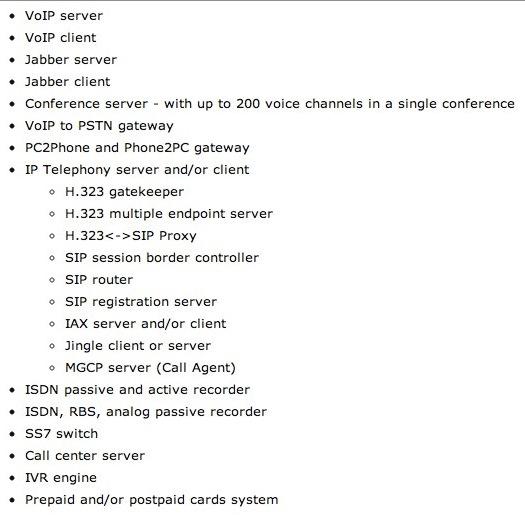
Just a heads up that the version of YATE being installed comes from an svn checkout several weeks ago. We zipped it up into a tarball which is downloaded as part of install-yate. With more recent builds, we have had problems with audio and the RTP stream. Until someone can sort out the issue, you’re well advised to stick with our snapshot if you want your calls to complete successfully.
Hopefully, today’s article will bring some of the YATE gurus out of the woodwork and inspire them to share their knowledge with the rest of the VoIP community. We’d be delighted to publish further articles. It’s a truly awesome platform. As I have mentioned to some of my colleagues, it reminds me of where the Asterisk community was about seven years ago. Much of the information about YATE is buried in endless threads of mailing list messages. This is an extremely difficult way to learn about and deploy a new technology. But we’re more than willing to do our part to spread the word. We’d also be happy to add a YATE Forum to the PIAF Forums so that everyone would have a searchable collection of tips in using YATE. Let us know what you think.
 Configuring Google Voice. As we mentioned, you’ll need a dedicated Google Voice account for this. The more obscure the username (with some embedded numbers), the better off you will be. This will keep folks from bombarding you with unsolicited Gtalk chat messages, and who knows what nefarious scheme will be discovered using Google messaging six months from now.
Configuring Google Voice. As we mentioned, you’ll need a dedicated Google Voice account for this. The more obscure the username (with some embedded numbers), the better off you will be. This will keep folks from bombarding you with unsolicited Gtalk chat messages, and who knows what nefarious scheme will be discovered using Google messaging six months from now.
We’ve tested this extensively using an existing Gmail account, and inbound calling is just not reliable. The reason seems to be that Google always chooses Gmail chat as the inbound call destination if there are multiple registrations from the same IP address. So, be reasonable. Do it our way! Set up a dedicated Gmail and Google Voice account, and use it exclusively for this new SIP gateway. Head over to the Google Voice site and register. If you’re living on another continent, see MisterQ’s posting for some tips on getting set up.
You must choose a telephone number (aka DID) for your new account, or Google Voice calling will not work… in either direction. You also have to tie your Google Voice account to at least one working phone number as part of the initial setup process. Your cellphone number will work just fine. Don’t skip this step either. Just enter the provided 2-digit confirmation code when you tell Google to place the test call to the phone number you entered. Once the number is registered, you can disable it if you’d like in Settings, Voice Setting, Phones. But…
IMPORTANT: Be sure to enable the Google Chat option as one of your phone destinations in Settings, Voice Setting, Phones. That’s the destination we need for the SIP gateway to work its magic! Otherwise, all inbound and outbound calls will fail. If you don’t see this option, you may need to call up Gmail and enable Google Chat there first. Then go back to the Google Voice Settings.
While you’re still in Google Voice Settings, click on the Calls tab. Make sure your settings match these:
- Call Screening – OFF
- Call Presentation – OFF
- Caller ID (In) – Display Caller’s Number
- Caller ID (Out) – Don’t Change Anything
- Do Not Disturb – OFF
- Call Options (Enable Recording) – OFF
- Global Spam Filtering – ON
Click Save Changes once you adjust your settings. Under the Voicemail tab, plug in your email address so you get notified of new voicemails. Down the road, receipt of a Google Voice voicemail will be a big hint that something has come unglued.
Next, go into Gmail for this same account and place a test call using your new Google Voice number. You’ll find the Call Phone icon in the Chat and SMS section of Gmail in the left column. Once you complete this step, be sure to log out of both Gmail and Google Voice for this account, or inbound calling will never work.
Finally, a heads up. If you are planning to use a Google Voice account that you set up previously from a different IP address, be advised that Google has some sophisticated protection mechanisms in place to deter the bad guys. As Bill Simon discovered, this may result in your not being able to connect to Google Voice from your new YIAF server. If that happens to you, follow the steps in this Google article to unlock your account.
Adding Accounts to YATE. Now that you have your Google Voice account set up and tested, we’re ready to add an account to YATE to manage it. First, be sure you have logged out of Gmail and Google Voice for the account you plan to use, or inbound calls will never make it to YATE. You’re going to need the following information to set up a new account on your YATE server:
Google Voice account name (without @gmail.com)
Google Voice account domain (usually gmail.com)
Google Voice account password
Google Voice 10-digit phone number
YATE account name will be auto-generated
YATE account password (make it very secure!)
IP address of your YATE server (unless colocated)
If you care about security, we’d strongly recommend you consider installing a NeoRouter VPN Client on both your YATE server and Asterisk server. Use the 10.0.0.x addresses for communications between the servers, and everything will be encrypted between the machines. It also greatly simplifies the firewall and security issues. If you’ve taken our advice and installed your YATE server with VPN in a Flash, then the VPN client is already in place. Just run nrclientcmd and fill in the blanks to activate it. For tips on VPN in a Flash server setup, see this article. Be sure to write down the 10.0.0.x address of your YATE server once you get the VPN client running.
To add a new account to YATE for your new Google Voice number, log into your YATE in a Flash server as root and issue the command: /root/add-yate-user (dedicated) or /root/add-piaf-yate-user (colocated). Fill in the blanks as shown above. Be sure to write down the FreePBX Trunk settings when they are displayed. You’ll need them in the next step.
Configuring FreePBX. To finish the install, you’ll need to open the FreePBX GUI on your PBX in a Flash server using a web browser. Here are the steps. If your system doesn’t already have a default inbound route pointing to Hangup, do that first: Setup -> Inbound Routes -> Add Incoming Route.
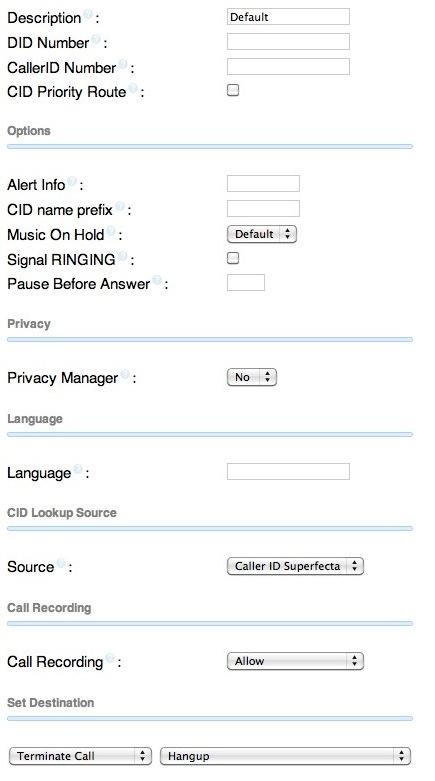
After you have the Default Inbound Route pointing to Hangup in place, only then is it advisable to Allow Anonymous SIP Calls. Any Anonymous SIP Call not handled by an Inbound Route will immediately be disconnected. You’ll find the Allow Anonymous SIP Calls option under Setup -> General Settings or Settings -> General Settings for FreePBX 2.10:

Once you have those two pieces in place, then you’re ready to Add a new SIP trunk, Outbound Route, and Inbound Route for each new Google Voice account that you add to YATE.
1. Add SIP Trunk. Choose Connectivity -> Trunks -> Add SIP Trunk and plug in the credentials that were provided when you added your Google Voice account to YATE. We recommend numbering your SIP trunks for Yate in sequential order, e.g. YIAF1, YIAF2, etc. We’re assuming YIAF1 is your Miami Google Voice trunk in this example so ignore the 843 area code. You’re smart enough to figure out your Miami Google Voice DID for yourself. This 10-digit Google Voice DID also goes on the end of the Register String after the hash tag (/) and is not shown below:
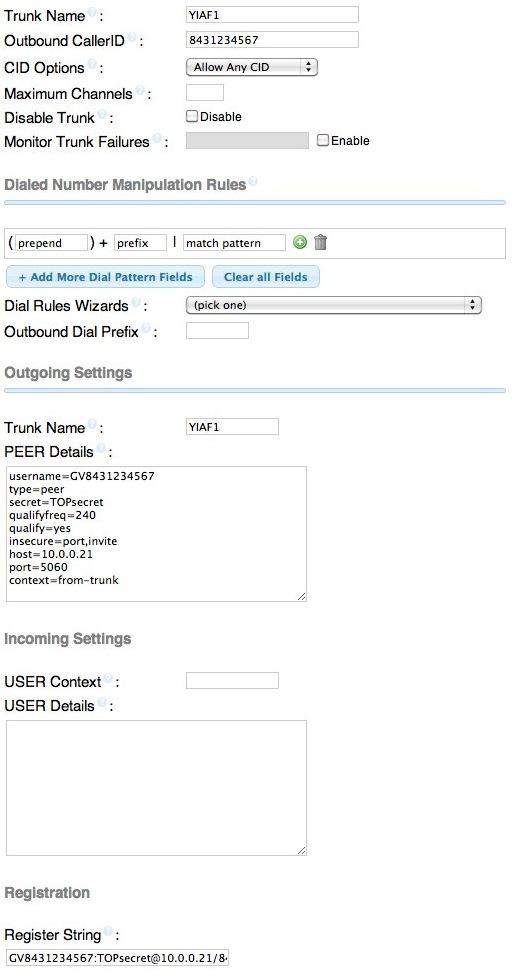
2. Add Outbound Route. Choose Connectivity -> Outbound Routes -> Add Outbound Route. Assuming this is the Outbound Route for your Miami Google Voice trunk, fill in the form in every spot we’ve placed a pink mark like this:
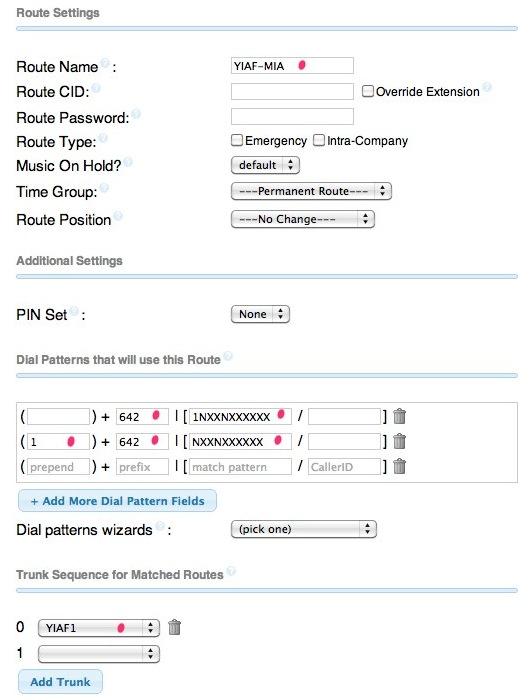
These dialing rules tell PBX in a Flash to dial out through the YIAF1 SIP trunk to Google Voice whenever a user dials a 10-digit or 11-digit number with the M-I-A (642) prefix. And it tells FreePBX to strip off the 642 and add a 1 (if it is missing) before sending the call to YATE. The SIP trunk settings in YIAF1 will assure that YATE places the outbound call on the Miami Google Voice trunk when it receives 1NXXNXXXXX from Asterisk.
3. Add Inbound Route. Incoming calls from the Miami Google Voice trunk will come into Asterisk as Anonymous SIP calls with the DID of the Google Voice trunk. In order to avoid an automatic Hangup, we need to create an Inbound Route for this DID. This will be the 10-digit DID of your Google Voice trunk and will match the 10-digit number on the end of the YIAF1 trunk’s Registration String. You can route these calls in any way you like on your Asterisk system, e.g. to an Extension, a Ring Group, an IVR, or whatever. Here’s an example for you to follow. Again, please ignore the non-Miami area code. We were too lazy to fix it.
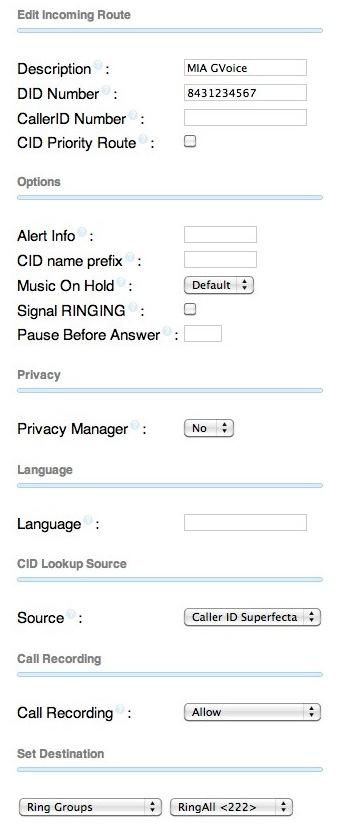
So there you have it. You’re now the proud owner of your own SIP-to-GoogleVoice Gateway courtesy of YATE and Bill Simon. You can add as many Google Voice trunks as you like. And you’ll have Google Voice connectivity with Asterisk 1.8, Asterisk 10, or Certified Asterisk without ever worrying about Asterisk "improvements" that break Google Voice down the road. To add additional trunks, do the following. On the YATE side, add-yate-user. And, on the PBX in a Flash side, complete FreePBX steps 1, 2, and 3 above using the credentials provided by add-yate-user. Enjoy!
NEWS FLASH: We are pleased to announce a new YATE Forum to provide support for YATE in a Flash as well as YATE. Come visit soon!
Originally published: Monday, June 25, 2012
Trials and Tribulations of a Service Provider. We have one of the best service providers in the business. WestNic has offered exemplary service and a secure computing platform to Nerd Vittles and PBX in a Flash for many years. We consume enormous computing resources for what we pay. But the last couple weeks have been painful. First, we were on vacation when WestNic made the transition (again) to PHP 5.3. These things usually happen in the middle of the night, and this was no exception. Unfortunately, we still were running a very old, highly customized (but very secure) version of WordPress. When morning came, Nerd Vittles died. We immediately knew why because we already had experienced PHP 5.3 a few months earlier, and WestNic graciously rolled it back… just for us. Unfortunately (for us), they didn’t tell us the new drop dead date. And, yes, we should have been updating WordPress. But it’s kinda like going to the dentist. You never quite get around to it until you have to. Well, now we had to. This involved backing up and restoring Nerd Vittles to another server still running the older version of PHP. So far, so good. It took about three hours to do the three WordPress updates, but all went well. Then we moved the site back to its home, and nothing worked again. Unfortunately, this hit on a weekend, and the weekend guys claimed it was a WordPress problem. It wasn’t this time, but it took until Monday morning to get the new php.ini file sorted out to accomodate PHP 5.3. Whew!
Then came the real fun. About 25% of the threads on the PBX in a Flash Forum could not be displayed. All you got was a blank screen when you clicked on a thread. As is customary with these types of issues, the XenForo developers blamed the provider. And the provider blamed XenForo. The provider uses mod_security to protect its web sites. But the provider assured us that nothing had changed. Well, nothing in mod_security anyway. After days and days of testing and back and forth, it turned out that the provider had added a new security mechanism, suhosin, which its developer touts as the "Guardian Angel" for PHP. That may be true for providers, but not so much for folks that actually depend upon their sites working. Welcome to a new can of worms!
Having been on both sides of this fence, we can readily appreciate the dilemma of the service providers. They don’t want their servers hacked. Denying access to all users would accomplish that goal but would reduce the number of paying customers pretty dramatically. So we all try to reach that happy medium trading off a little security for a bit more access. In this case, it turned out to be a couple of suhosin settings that monitor the length of URLs. We discovered that only after running literally hundreds of tests. Since XenForo’s forum software makes extensive use of lengthy URLs to maintain compatibility with older vBulletin posts, this caused a problem. HTML requests with URLs exceeding a certain length are simply thrown in the bit bucket by suhosin. The biggest hint was sitting in the service provider’s Apache log, but we had no access to that information, and they never looked until two and a half days after we first opened a trouble ticket. No errors appeared in our logs, and users got nothing but blank pages where the subject of a post on the forum exceeded 50 characters. Fortunately, that was enough of a hint to finally resolve the problem. The unfortunate part of this story is that, without 25 years of personal IT experience plus over 100 IT gurus that visit our sites regularly, it’s doubtful this ever would have gotten resolved other than by begging the provider to turn off mod_security and suhosin for our sites, something we were unwilling to do. If something similar ever happens to you, the command you need to know is php -v. This will tell you what’s running with PHP on your host. Our provider had implied that suhosin had not yet been activated. php -v suggested just the opposite. So did their error log once they looked. The other place to start searching for configuration information is /usr/local/lib/php.ini. This will tell you how your provider has PHP configured and whether your local php.ini file is even activated. Our provider suggested more than once that our local php.ini file had been misconfigured. We’d never touched it and, in our case, the server’s php.ini file indicated that it was never activated regardless of what its contents may have contained.
We’re glad everything is fixed. We all learned more than we ever wanted to know about suhosin. Still wishing there had been a little better communications with our provider. It would have made resolution a lot easier and quicker for all concerned. It’s especially difficult to resolve thorny issues like this using service tickets with response times of half a day per message. Did we mention there is virtually no documentation on suhosin and what each of its several dozen settings actually do. Our apologies to everyone that was impacted by the service disruptions. We’re glad it’s behind us.

Need help with Asterisk? Visit the NEW PBX in a Flash Forum.
whos.amung.us If you’re wondering what your fellow man is reading on Nerd Vittles these days, wonder no more. Visit our new whos.amung.us statistical web site and check out what’s happening. It’s a terrific resource both for us and for you.
Special Thanks to Our Generous Sponsors
FULL DISCLOSURE: ClearlyIP, Skyetel, Vitelity, DigitalOcean, Vultr, VoIP.ms, 3CX, Sangoma, TelecomsXchange and VitalPBX have provided financial support to Nerd Vittles and our open source projects through advertising, referral revenue, and/or merchandise. As an Amazon Associate and Best Buy Affiliate, we also earn from qualifying purchases. We’ve chosen these providers not the other way around. Our decisions are based upon their corporate reputation and the quality of their offerings and pricing. Our recommendations regarding technology are reached without regard to financial compensation except in situations in which comparable products at comparable pricing are available from multiple sources. In this limited case, we support our sponsors because our sponsors support us.
 BOGO Bonaza: Enjoy state-of-the-art VoIP service with a $10 credit and half-price SIP service on up to $500 of Skyetel trunking with free number porting when you fund your Skyetel account. No limits on number of simultaneous calls. Quadruple data center redundancy. $25 monthly minimum spend required. Tutorial and sign up details are here.
BOGO Bonaza: Enjoy state-of-the-art VoIP service with a $10 credit and half-price SIP service on up to $500 of Skyetel trunking with free number porting when you fund your Skyetel account. No limits on number of simultaneous calls. Quadruple data center redundancy. $25 monthly minimum spend required. Tutorial and sign up details are here.
 The lynchpin of Incredible PBX 2020 and beyond is ClearlyIP components which bring management of FreePBX modules and SIP phone integration to a level never before available with any other Asterisk distribution. And now you can configure and reconfigure your new Incredible PBX phones from the convenience of the Incredible PBX GUI.
The lynchpin of Incredible PBX 2020 and beyond is ClearlyIP components which bring management of FreePBX modules and SIP phone integration to a level never before available with any other Asterisk distribution. And now you can configure and reconfigure your new Incredible PBX phones from the convenience of the Incredible PBX GUI.
 VitalPBX is perhaps the fastest-growing PBX offering based upon Asterisk with an installed presence in more than 100 countries worldwide. VitalPBX has generously provided a customized White Label version of Incredible PBX tailored for use with all Incredible PBX and VitalPBX custom applications. Follow this link for a free test drive!
VitalPBX is perhaps the fastest-growing PBX offering based upon Asterisk with an installed presence in more than 100 countries worldwide. VitalPBX has generously provided a customized White Label version of Incredible PBX tailored for use with all Incredible PBX and VitalPBX custom applications. Follow this link for a free test drive!
 Special Thanks to Vitelity. Vitelity is now Voyant Communications and has halted new registrations for the time being. Our special thanks to Vitelity for their unwavering financial support over many years and to the many Nerd Vittles readers who continue to enjoy the benefits of their service offerings. We will keep everyone posted on further developments.
Special Thanks to Vitelity. Vitelity is now Voyant Communications and has halted new registrations for the time being. Our special thanks to Vitelity for their unwavering financial support over many years and to the many Nerd Vittles readers who continue to enjoy the benefits of their service offerings. We will keep everyone posted on further developments.
Some Recent Nerd Vittles Articles of Interest…
5-Minute VoIP: Deploying a SIP to Google Voice Gateway

We’ve been big fans of Google Voice since the outset. But, with the exception of one brief week, the piece Google has always refused to put in place is a SIP gateway to make connections from VoIP devices a no-brainer. You’d think they’d do it for no other reason than economics. SIP calls are free. PSTN calls are not. Well, never mind Google. Bill Simon has done it for you, and he leveraged the same Yate toolkit that Google originally deployed. Today, we’ll show you how to spend five minutes and take advantage of the Simon Telephonics gateway to interconnect a dedicated Google Voice account with any SIP device you’d like, whether it’s an Asterisk® server, a smartphone with a free SIP client from GrooVe IP or Zoiper, a free softphone from Zoiper or X-Lite 4, or any SIP telephone. Once we’re finished today, you can use any SIP client to call your 10-digit Google Voice number through the Simon Telephonics gateway: SIP/9991234567@gvgw1.simonics.com. And you can make and receive calls throughout the U.S. and Canada using your new Google Voice number the old fashioned way, using a Plain Old Telephone. Did we mention that everything is free: the Google Voice number, the Simon Telephonics gateway connection, all of the inbound calls, and outbound calls throughout the U.S. and Canada… at least in 2012. If you take advantage of Bill’s gateway, we would encourage you to at least donate one day’s lunch money to Bill’s site to help pay the light bill.
Getting Started. The drill for today goes like this. First, you’ll create a new Google Voice account with a new phone number at google.com/voice. Next, you’ll make a test call from that number using the Gmail account associated with that same account. Then, you’ll register the Google Voice number on the Simon Telephonics gateway. Next, we’ll set up a SIP trunk on your Asterisk server for this new DID. Finally, configure any SIP client with an extension number from your Asterisk PBX, and you can start making and receiving calls using your new Google Voice number.
A Word About Security. Google doesn’t (yet) support OAuth authentication for Google Voice accounts. What this means is that you’ll have to use your actual Google Voice credentials to set up your account on the Simon Telephonics gateway. Could Bill steal your credentials? Absolutely. Will he? Absolutely not. Why? First, there’s no money in your Google Voice account so all he could do is make free calls on Google’s nickel, the same thing he could do using his own Google Voice accounts. Second, Bill is better off setting up his own accounts where you don’t share his password and the Google Voice call logs won’t tell you who he’s calling. If you’re paranoid, don’t put money in your calling account, make the account name something that could not be associated with you, and then check your call logs several times every day. Better yet, spend $50 and use an OBi110 device to set up your own private gateway where Obihai knows your credentials instead of Bill. 😉
 Configuring Google Voice. As we mentioned, you’ll need a dedicated Google Voice account for this. The more obscure the username (with some embedded numbers), the better off you will be. This will keep folks from bombarding you with unsolicited Gtalk chat messages, and who knows what nefarious scheme will be discovered using Google messaging six months from now.
Configuring Google Voice. As we mentioned, you’ll need a dedicated Google Voice account for this. The more obscure the username (with some embedded numbers), the better off you will be. This will keep folks from bombarding you with unsolicited Gtalk chat messages, and who knows what nefarious scheme will be discovered using Google messaging six months from now.
We’ve tested this extensively using an existing Gmail account, and inbound calling is just not reliable. The reason seems to be that Google always chooses Gmail chat as the inbound call destination if there are multiple registrations from the same IP address. So, be reasonable. Do it our way! Set up a dedicated Gmail and Google Voice account, and use it exclusively for this new SIP gateway. Head over to the Google Voice site and register. If you’re living on another continent, see MisterQ’s posting for some tips on getting set up.
You must choose a telephone number (aka DID) for your new account, or Google Voice calling will not work… in either direction. You also have to tie your Google Voice account to at least one working phone number as part of the initial setup process. Your cellphone number will work just fine. Don’t skip this step either. Just enter the provided 2-digit confirmation code when you tell Google to place the test call to the phone number you entered. Once the number is registered, you can disable it if you’d like in Settings, Voice Setting, Phones. But…
IMPORTANT: Be sure to enable the Google Chat option as one of your phone destinations in Settings, Voice Setting, Phones. That’s the destination we need for the SIP gateway to work its magic! Otherwise, all inbound and outbound calls will fail. If you don’t see this option, you may need to call up Gmail and enable Google Chat there first. Then go back to the Google Voice Settings.
While you’re still in Google Voice Settings, click on the Calls tab. Make sure your settings match these:
- Call Screening – OFF
- Call Presentation – OFF
- Caller ID (In) – Display Caller’s Number
- Caller ID (Out) – Don’t Change Anything
- Do Not Disturb – OFF
- Call Options (Enable Recording) – OFF
- Global Spam Filtering – ON
Click Save Changes once you adjust your settings. Under the Voicemail tab, plug in your email address so you get notified of new voicemails. Down the road, receipt of a Google Voice voicemail will be a big hint that something has come unglued.
Finally, go into Gmail for this same account and place a test call using your new Google Voice number. You’ll find the Call Phone icon in the Chat and SMS section of Gmail in the left column. Once you complete this step, be sure to log out of both Gmail and Google Voice for this account, or inbound calling will never work.
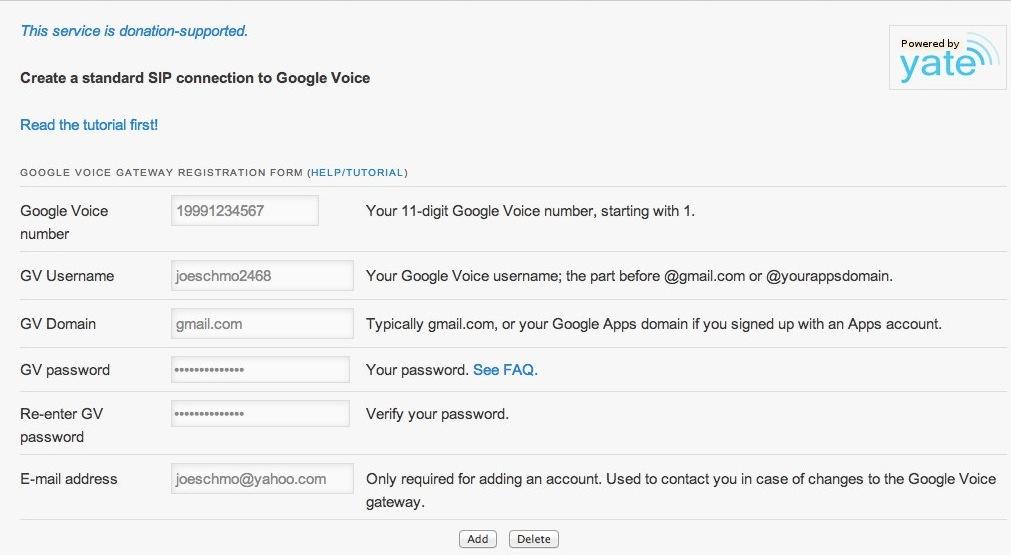
Registering on the Simon Telephonics Gateway. Now we’re ready to register your Google Voice account on the Simon Telephonics Gateway. Click on the link and fill in the blanks with your Google Voice account credentials and phone number. Be sure to include a 1 at the beginning of your Google Voice number! You’ll note that Google Apps email domains are supported as well as gmail.com addresses.
- Google Voice Number – 19991234567
- GV Username – joeschmo2468
- GV Domain – gmail.com
- GV Password – mightysecret
- GV Password again – mightysecret
- Email Address – joeschmo@yahoo.com
Check your entries carefully and then click the Add button. The only way to make changes if you screw things up is to delete the existing account by entering your original credentials to Delete the original account and then you Add a new one. So type carefully and check your work. Once your account is successfully registered, the Simon Telephonics Gateway will spit back your new SIP credentials. Write them down or take a screenshot and put them in a safe place. You’ll need them to set up your Asterisk SIP trunk. The Username will be your 11-digit Google Voice number with a GV prefix. The Secret will be a randomized string. The Registration String will be used in setting up your Asterisk SIP trunk and is in the proper format. The DID for your Inbound Route in FreePBX® will be your 11-digit Google Voice number.
- Server – gvgw1.simonics.com
- Username – GV19991234567
- Secret – Xyzkk
- Registration String – GV19991234567:Xyzkk@gvgw1.simonics.com/19991234567
- Dialing Format – E.164 without + (for US calls, 11 digits starting with 1)
NOTE: Newer users may be provided an alternate gateway, e.g. gvgw2.simonics.com. You would obviously need to use whichever gateway FQDN is provided in all of the settings shown here.
Creating FreePBX SIP Trunk. Now we’re ready to create your new SIP trunk in FreePBX. Choose Add SIP Trunk and fill in the blanks as shown below with your new credentials. The Trunk Name can be any name you like. Don’t forget the 1 in Prepend for the Dialed Number Manipulation Rules! Leave the Incoming Settings blank. Be sure to add your Registration String from the credentials that were provided as part of the Simon Telephonics registration. Then Save Your Settings.
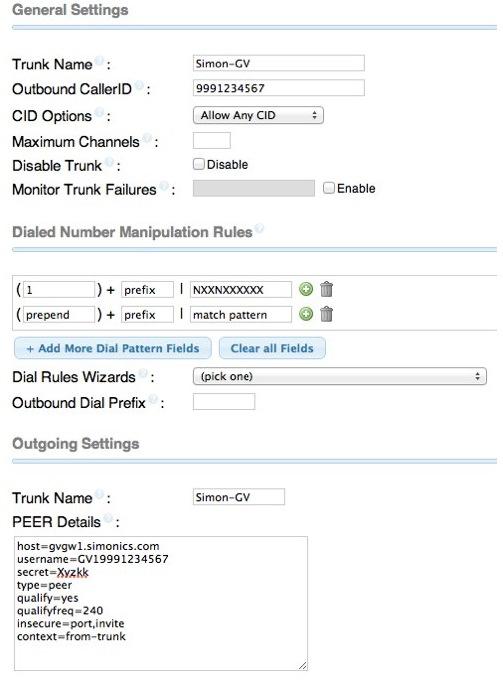
Creating FreePBX Inbound Route. Now you’ll need to add an Inbound Route to process incoming calls from the Simon Telephonics Gateway. The DID entry will be your 11-digit Google Voice number. The Destination for the incoming calls can be whatever you like: an extension, a ring group, an IVR, or any of the other available options on your server.
Creating FreePBX Outbound Route. If you want to send outbound calls out through your new Google Voice trunk, then you’ll need to add the SIP trunk to your outbound dialing rules. Just add the SIP Trunk Name you’ve defined to the Trunk Sequence for calls with the NXXNXXXXXX Dial Pattern, and you’re all set. Enjoy!
Originally published: Monday, June 11, 2012
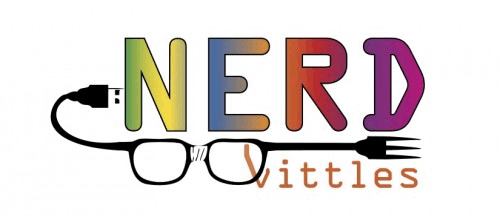
Need help with Asterisk? Visit the PBX in a Flash Forum.
whos.amung.us If you’re wondering what your fellow man is reading on Nerd Vittles these days, wonder no more. Visit our new whos.amung.us statistical web site and check out what’s happening. It’s a terrific resource both for us and for you.
Special Thanks to Our Generous Sponsors
FULL DISCLOSURE: ClearlyIP, Skyetel, Vitelity, DigitalOcean, Vultr, VoIP.ms, 3CX, Sangoma, TelecomsXchange and VitalPBX have provided financial support to Nerd Vittles and our open source projects through advertising, referral revenue, and/or merchandise. As an Amazon Associate and Best Buy Affiliate, we also earn from qualifying purchases. We’ve chosen these providers not the other way around. Our decisions are based upon their corporate reputation and the quality of their offerings and pricing. Our recommendations regarding technology are reached without regard to financial compensation except in situations in which comparable products at comparable pricing are available from multiple sources. In this limited case, we support our sponsors because our sponsors support us.
 BOGO Bonaza: Enjoy state-of-the-art VoIP service with a $10 credit and half-price SIP service on up to $500 of Skyetel trunking with free number porting when you fund your Skyetel account. No limits on number of simultaneous calls. Quadruple data center redundancy. $25 monthly minimum spend required. Tutorial and sign up details are here.
BOGO Bonaza: Enjoy state-of-the-art VoIP service with a $10 credit and half-price SIP service on up to $500 of Skyetel trunking with free number porting when you fund your Skyetel account. No limits on number of simultaneous calls. Quadruple data center redundancy. $25 monthly minimum spend required. Tutorial and sign up details are here.
 The lynchpin of Incredible PBX 2020 and beyond is ClearlyIP components which bring management of FreePBX modules and SIP phone integration to a level never before available with any other Asterisk distribution. And now you can configure and reconfigure your new Incredible PBX phones from the convenience of the Incredible PBX GUI.
The lynchpin of Incredible PBX 2020 and beyond is ClearlyIP components which bring management of FreePBX modules and SIP phone integration to a level never before available with any other Asterisk distribution. And now you can configure and reconfigure your new Incredible PBX phones from the convenience of the Incredible PBX GUI.
 VitalPBX is perhaps the fastest-growing PBX offering based upon Asterisk with an installed presence in more than 100 countries worldwide. VitalPBX has generously provided a customized White Label version of Incredible PBX tailored for use with all Incredible PBX and VitalPBX custom applications. Follow this link for a free test drive!
VitalPBX is perhaps the fastest-growing PBX offering based upon Asterisk with an installed presence in more than 100 countries worldwide. VitalPBX has generously provided a customized White Label version of Incredible PBX tailored for use with all Incredible PBX and VitalPBX custom applications. Follow this link for a free test drive!
 Special Thanks to Vitelity. Vitelity is now Voyant Communications and has halted new registrations for the time being. Our special thanks to Vitelity for their unwavering financial support over many years and to the many Nerd Vittles readers who continue to enjoy the benefits of their service offerings. We will keep everyone posted on further developments.
Special Thanks to Vitelity. Vitelity is now Voyant Communications and has halted new registrations for the time being. Our special thanks to Vitelity for their unwavering financial support over many years and to the many Nerd Vittles readers who continue to enjoy the benefits of their service offerings. We will keep everyone posted on further developments.
Some Recent Nerd Vittles Articles of Interest…
Googlicious: News, Weather, Stocks & Dictionary for Asterisk
 Let’s face it. There are certain kinds of information you just don’t want to be without. And now a treasure trove of Google content is as close as your nearest Asterisk® telephone. Thanks to Google and Lefteris Zafiris, open source Asterisk text-to-speech (TTS) and speech-to-text (STT) tools are having a banner year. We wanted to join the party and offer a free collection of new Asterisk apps in conjunction with Lefteris’ new toolkits so you can take advantage of Google’s latest news, weather, and stock feeds as well as Google’s online dictionaries. Read all about the Google XML feeds here. As with most of Google’s experimental projects, there’s no guarantee that these feeds will work next year… or even next week.
Let’s face it. There are certain kinds of information you just don’t want to be without. And now a treasure trove of Google content is as close as your nearest Asterisk® telephone. Thanks to Google and Lefteris Zafiris, open source Asterisk text-to-speech (TTS) and speech-to-text (STT) tools are having a banner year. We wanted to join the party and offer a free collection of new Asterisk apps in conjunction with Lefteris’ new toolkits so you can take advantage of Google’s latest news, weather, and stock feeds as well as Google’s online dictionaries. Read all about the Google XML feeds here. As with most of Google’s experimental projects, there’s no guarantee that these feeds will work next year… or even next week.
With all of these new Nerd Vittles applications, you simply say what you want and leave the driving to us. To speed up the response time, just press # after saying what you’re looking for. For the weather application, get a current weather report and forecast for almost any city in the entire world. Just say the name of the city and the state, province, or country, e.g. Paris, France or Vancouver, British Columbia, or Huntsville, Alabama. You also can say the zip code or postal code for U.S. and Canadian cities if you prefer. And you can predefine 10 zip codes or postal codes for quick searches by just saying: "Number 2." We’ve predefined 0 through 9 for major Canadian cities to give you a head start. These can be changed in any way you like, including U.S. zip codes or even city and state (with no punctuation). And ignore the fact that the data array is named $canada. We were too lazy to change it to something more generic once we broadened the scope of the application. 🙄
But suppose you don’t want to choose a city and state or province. Instead you want to say a thorny Canadian mail code such as B2N 1X6. Well, now there’s a way to tell the software to let you do it phonetically. Just say: "phonetic bravo 2 nancy 1 xray 6" using any words that start with the same letters as the letters in the mail code.

The stock reports work in a similar way. Just say the name of the company’s ticker symbol and press #. Or you can predefine 10 companies to watch. Then quickly access the (almost) current trading price of your ten favorites by saying: "Number 9." We’ve predefined 10 stocks to watch to get you started. Change the entries to meet your needs by editing nv-stocks-google.php in /var/lib/asterisk/agi-bin.

What we’ve learned in building STT applications is that saying individual letters is not Google’s finest hour in speech-to-text transcription. The reason is that Google built their transcription service primarily to support conversational speech and voicemail transcription, and most folks don’t spell out words. They just say them. So… if you have problems getting good results by spelling out I-B-M, try this: "letter i, letter b, letter m." Or, better yet, just use the predefined stock option to set up your 10 favorite stocks. Then say "number 6″ whenever you want to retrieve the current trading price of Microsoft:

With the stock reports, we’ve also added the NATO phonetic alphabet to our bag of tricks. So, for I-B-M, you can simply say "India Bravo Mike" and the words will be converted to "IBM." If it’s been a while since your soldiering days, here’s a cheat sheet for you. Actually, the code is smart enough to understand any words that begin with the same letter as any particular character in the stock symbol so long as Google understands you. For example, saying "monkey smells furry things" would return the Microsoft (MSFT) stock report. Heh.

With the news headlines, you don’t have to do anything but dial the extension number and listen to the news. The number of news stories played can be adjusted by changing the 5 in line 6 of the 951 extension of /etc/asterisk/ extensions_custom.conf.
To access the online dictionaries, you have two choices. Either use Google’s own dictionary or you can open your search up to the entire web and take advantage of a much broader selection of information including Wikipedia, the Urban Dictionary, and the Free Encyclopedia. Just dial 333 and say one of the following: "define nerd" or "web define rocket scientist." You get the idea.
Prerequisites. There’s lots of Linux code necessary to make all of this work. Lucky for you, all of it comes preinstalled in the latest PBX in a Flash releases regardless of the flavor you’re running. You’ll also need activate at least one Google Voice account on your Asterisk server if you plan to use the dictionary application. If you’re using some other distribution, all we can suggest is that you peel our install script apart and attempt to install each piece. Linux is pretty good at telling you which dependencies are missing.
Installation. Installing these STT/TTS applications couldn’t be easier. It takes less than a minute on PBX in a Flash systems. Log into your server as root and issue the following commands:
cd /root
wget http://incrediblepbx.com/google-apps.tgz
tar zxvf google-apps.tgz
./install-google-apps
Using the STT/TTS Apps. From any telephone connected to your Asterisk server, just dial the following numbers to access the three Google STT/TTS applications:
- 333 – Dictionary
- 949 – Weather
- 950 – Stocks
- 951 – News Headlines
To meet your own needs, don’t forget to adjust the quick call entries in the weather and stocks AGI scripts. And remember to use the "letter" and "number" tricks to improve accuracy. There’s also some experimental code that you may wish to read about and take for a test drive.
Nerd’s Nugget: We’ve been wrestling with a new methodology to make it easy for folks to update Nerd Vittles apps by simply running the installer a second or third time. Today marks the beginning of this new approach. If you look at the dialplan code in extensions_custom.conf, you’ll see each TTS extension begins like this: ;# // BEGIN nv-weather-google. And the extension ends with a matching marker: ;# // END nv-weather-google. What this does is make it incredibly easy to remove the code using a single SED command:
sed -i ‘\:// BEGIN nv-weather-google:,\:// END nv-weather-google:d’ /etc/asterisk/extensions_custom.conf
We’ll post changes and additions for today’s scripts on the PIAF Forum. Join by clicking on the link below.
Originally published: Monday, May 14, 2012
Updated: Monday, May 28, 2012

Need help with Asterisk? Visit the PBX in a Flash Forum.
whos.amung.us If you’re wondering what your fellow man is reading on Nerd Vittles these days, wonder no more. Visit our new whos.amung.us statistical web site and check out what’s happening. It’s a terrific resource both for us and for you.
Special Thanks to Our Generous Sponsors
FULL DISCLOSURE: ClearlyIP, Skyetel, Vitelity, DigitalOcean, Vultr, VoIP.ms, 3CX, Sangoma, TelecomsXchange and VitalPBX have provided financial support to Nerd Vittles and our open source projects through advertising, referral revenue, and/or merchandise. As an Amazon Associate and Best Buy Affiliate, we also earn from qualifying purchases. We’ve chosen these providers not the other way around. Our decisions are based upon their corporate reputation and the quality of their offerings and pricing. Our recommendations regarding technology are reached without regard to financial compensation except in situations in which comparable products at comparable pricing are available from multiple sources. In this limited case, we support our sponsors because our sponsors support us.
 BOGO Bonaza: Enjoy state-of-the-art VoIP service with a $10 credit and half-price SIP service on up to $500 of Skyetel trunking with free number porting when you fund your Skyetel account. No limits on number of simultaneous calls. Quadruple data center redundancy. $25 monthly minimum spend required. Tutorial and sign up details are here.
BOGO Bonaza: Enjoy state-of-the-art VoIP service with a $10 credit and half-price SIP service on up to $500 of Skyetel trunking with free number porting when you fund your Skyetel account. No limits on number of simultaneous calls. Quadruple data center redundancy. $25 monthly minimum spend required. Tutorial and sign up details are here.
 The lynchpin of Incredible PBX 2020 and beyond is ClearlyIP components which bring management of FreePBX modules and SIP phone integration to a level never before available with any other Asterisk distribution. And now you can configure and reconfigure your new Incredible PBX phones from the convenience of the Incredible PBX GUI.
The lynchpin of Incredible PBX 2020 and beyond is ClearlyIP components which bring management of FreePBX modules and SIP phone integration to a level never before available with any other Asterisk distribution. And now you can configure and reconfigure your new Incredible PBX phones from the convenience of the Incredible PBX GUI.
 VitalPBX is perhaps the fastest-growing PBX offering based upon Asterisk with an installed presence in more than 100 countries worldwide. VitalPBX has generously provided a customized White Label version of Incredible PBX tailored for use with all Incredible PBX and VitalPBX custom applications. Follow this link for a free test drive!
VitalPBX is perhaps the fastest-growing PBX offering based upon Asterisk with an installed presence in more than 100 countries worldwide. VitalPBX has generously provided a customized White Label version of Incredible PBX tailored for use with all Incredible PBX and VitalPBX custom applications. Follow this link for a free test drive!
 Special Thanks to Vitelity. Vitelity is now Voyant Communications and has halted new registrations for the time being. Our special thanks to Vitelity for their unwavering financial support over many years and to the many Nerd Vittles readers who continue to enjoy the benefits of their service offerings. We will keep everyone posted on further developments.
Special Thanks to Vitelity. Vitelity is now Voyant Communications and has halted new registrations for the time being. Our special thanks to Vitelity for their unwavering financial support over many years and to the many Nerd Vittles readers who continue to enjoy the benefits of their service offerings. We will keep everyone posted on further developments.
Some Recent Nerd Vittles Articles of Interest…
PIAF 2.0.6.2.3: It’s PIAF-Brown with Certified Asterisk

Today we're delighted to take Asterisk® to the next plateau with an all-new release of PBX in a Flash™. Tom King's latest masterpiece gives you unparalleled flexibility with the ease of installation and security you've come to expect from all PIAF™ releases. Featuring CentOS® 6.2, this new release provides your choice of the most stable versions of Asterisk 1.8 or 10 and now includes the option to install the new Certified Asterisk release from Digium® featuring SLA support for the first time. Certified Asterisk also brings plug-and-play support for Digium Phones. And, of course, you still get your choice of FreePBX® 2.8, 2.9, or 2.10 as well as one-click installs for Incredible PBX and Incredible Fax. No other platform gives YOU this kind of flexibility to easily design a telephony platform that meets all your unique requirements.
We're also pleased to announce that, in addition to the one-of-a-kind PBX in a Flash Forum, we're adding what many of you have requested, a paid support service from the best folks in the business for organizations that truly need immediate technical assistance when something comes unglued. More details are coming in the next few weeks so stay tuned.

Featuring superior scalability, improved performance, better resource management, and unmatched device support, PBX in a Flash 2.0.6.2 brings you the most versatile Asterisk platform on the planet with the latest and greatest releases of virtually every major open source product in the marketplace. And you can choose either the 32-bit or 64-bit platform. For those needing additional Asterisk customization, PIAF2 also provides direct access to Asterisk's menuconfig system which lets you tailor the selection of Asterisk modules you wish to deploy. With 2.0.6.2.3, we've included a new menu-driven installation option that lets you add network drivers for many of the latest and greatest network cards that are not yet supported in the Linux kernel. We've also updated the kernel to eliminate many of the bugs reported in the default CentOS 6.2 kernel. And, of course, PIAF2 continues to provide the only turnkey Google Voice solution providing immediate free calling throughout the U.S. and Canada with any of the default flavors of PIAF.
Here's how the new install works. Step #1 is downloading the ISO and burning a CD (32-bit) or DVD (64-bit) to install your new server. If your machine lacks a CD/DVD drive, there's now a simple procedure for building a USB Flash Drive installer. Once you boot your server using the installer you created, you first get to select the file system for your new CentOS server. For most folks, just press the Enter key. Next, you'll be prompted to create a very secure root password. Then the PIAF2 disk will whir away for about 15 minutes installing CentOS 6.2. As your system reboots, remove the install disk and the second phase of the install begins.
The PIAF2 Install Menu will display. It looks like this:

Adding a Network Driver. In addition to choices to select your flavor of Asterisk to install, the main install menu now includes an option to load Add-On network drivers. With Linux, network drivers have to be part of the Linux kernel to work. And you must have Internet connectivity to complete the Phase II install of PBX in a Flash. So this eliminates the chicken-and-the-egg problem. As new hardware appears, the latest drivers haven't yet made it into the kernel. So we now let you add the one you need from the Extra Drivers Menu. It's literally plug-and-play. Click the driver you need, and presto it's added. Reboot to return to the Install Menu and continue your install. By the way, if you don't know what type network card you have in your system, drop down to the Linux CLI, log in as root, and type: lspci. Then continue by entering the command: piafdl.

Unlike other distros, we build your server the old-fashioned way, from source, and then compile the various components. This gives you the flexibility to add new features and recompile your applications down the road when new additions become available that you'd like to include in your system. It also provides the flexibility to adjust your Asterisk setup to meet your specific requirements. In short, it's just as if you'd installed Asterisk manually from source code. Why? Because you have!
Choosing a Custom Version of Asterisk. From the Main Install Menu, you also have the option of exiting to the Linux command prompt to select from a broad list of newer Asterisk releases. If you choose this option, you'll be prompted to log into your server as root with the root password you chose initially. Once logged in, you can execute any series of Linux commands or issue one of the following commands to choose a specific release of Asterisk:
- piafdl -p beta_1880_purple (loads Asterisk 1.8.8.0)
- piafdl -p beta_1881_purple (loads Asterisk 1.8.8.1)
- piafdl -p beta_1882_purple (loads Asterisk 1.8.8.2)
- piafdl -p beta_1890_purple (loads Asterisk 1.8.9.0)
- piafdl -p beta_1891_purple (loads Asterisk 1.8.9.1)
- piafdl -p beta_1892_purple (loads Asterisk 1.8.9.2)
- piafdl -p beta_1893_purple (loads Asterisk 1.8.9.3)
- piafdl -p beta_18101_purple (loads Asterisk 1.8.10.1)
- piafdl -p beta_18110_purple (loads Asterisk 1.8.11.0)
- piafdl -p beta_18111_purple (loads Asterisk 1.8.11.1)
- piafdl -p beta_18120_purple (loads Asterisk 1.8.12.0)
- piafdl -p beta_1811_brown (loads Asterisk 1.8.11-cert1)
- piafdl -p beta_1000_red (loads Asterisk 10.0.0)
- piafdl -p beta_1001_red (loads Asterisk 10.0.1)
- piafdl -p beta_1010_red (loads Asterisk 10.1.0)
- piafdl -p beta_1011_red (loads Asterisk 10.1.1)
- piafdl -p beta_1012_red (loads Asterisk 10.1.2)
- piafdl -p beta_1013_red (loads Asterisk 10.1.3)
- piafdl -p beta_1020_red (loads Asterisk 10.2.0)
- piafdl -p beta_1021_red (loads Asterisk 10.2.1)
- piafdl -p beta_1030_red (loads Asterisk 10.3.0)
- piafdl -p beta_10311_red (loads Asterisk 10.3.1.1)
- piafdl -p beta_1040_red (loads Asterisk 10.4.0)
Be advised that Asterisk 10.1.x and later releases reportedly break Google Voice! The good news is that the new PIAF deployment methodology for newer Asterisk releases is working. We no longer incorporate the latest Asterisk release as the default PIAF install. Instead, you get a version that has undergone thorough independent testing by our gurus. So the base PIAF install of Asterisk 10 still gets you a version of Asterisk that reliably supports Google Voice.
Picking a Flavor of Asterisk. Many of you already know which branch of Asterisk you prefer to install, but some don't. If there's not a particular reason for choosing PIAF-Red with Asterisk 10, don't. The reason is that support for it ends within the year. PIAF-Purple with Asterisk 1.8 on the other hand will be supported with bug fixes for several more years. And, if you value an SLA (meaning reported bugs will get fixed) or you want to use Digium Phones, then PIAF-Brown is your only option at the moment. Even though it is new, it is based upon a stable version of Asterisk 1.8. We're running it with good results. YMMV!
The Config Module. Once you choose your flavor of Asterisk, the PIAF2 install will continue by loading the Config Module. Within this module, you do the following:
First, you get to choose whether to access the Asterisk menuconfig utility which lets you select which modules of Asterisk to install. Don't pick this option unless you know what you're doing and need something special. We've enabled all of the options that most folks need.
Second, you'll be prompted to choose your Time Zone. Choose from one of the options provided, and press Y to confirm your choice.
Third, you'll be prompted to choose your flavor of FreePBX to install: 2.8, 2.9, or 2.10. This choice is important. If you want to use Incredible PBX or Incredible Fax or both, then you must select either FreePBX 2.9 or 2.10. If you want to use the FreePBX Digium Phones module, then your only choice is FreePBX 2.10. While it's possible to upgrade FreePBX to a later version in place, it's not painless so make your selection carefully.
Fourth, you must assign a password for access to the FreePBX GUI and utilities. Make it secure or let the system pick one for you. It's your phone bill.
Finally, press Enter to confirm your selections. Then go have a cup of coffee. The install process will continue for 15-30 minutes depending upon the speed of your server and network connection. The necessary components that you've chosen will be downloaded and compiled. You'll also get an updated CentOS 6.2 system as all of the yum updates are applied for your server.
When the install finishes, your system will reboot a final time and then you'll have a working PIAF2 server.
What Next? Before you make any changes using FreePBX, you have a few decisions to make. If you plan to use Incredible PBX and/or Incredible Fax, you need to install them now in the order shown because they overwrite all of your FreePBX settings. Now would be a good time to read the Nerd Vittles article which explains the functionality and installation process for these two great products.
If you want to use Incredible PBX, install it first! Log in to the Linux CLI and issue the command: install-incredpbx3.
If you want free faxing support for your PIAF2 server, install it after Incredible PBX by issuing the command: install-incredfax2.

If you are using PIAF-Brown with FreePBX 2.10 and want to take advantage of the FreePBX Digium Phones module (shown above), now's the time to install it after the other two installs above:
Step #1: Obtain a free Digium DPMA license key for your server.
Step #2: Log in as root and issue the command: install-digiphones.
FreePBX Setup. Most of your time with PIAF2 will be spent using a browser and the FreePBX GUI. To get to it, you'll need the IP address of your server. Log into the Linux CLI as root using your root password. Write down the IP address of your server from the status display (below) and verify that everything installed properly. Note that Samba is disabled by default. If you want to use your server with Windows Networking, run configure-samba once your server is up and running.

Once you have the IP address of your server, just point your browser to that IP address to bring up the PIAF GUI (shown below). Review the PIAF RSS Feed. We recommend checking this RSS Feed daily by pointing your browser to the IP address of your server. The RSS Feed is displayed in the left column of the GUI and will alert you to any newly discovered security vulnerabilities in CentOS, Asterisk, FreePBX, or PIAF2. Click on the Users tab to change to the Admin panel, and then select FreePBX to load the FreePBX GUI.

You also can access the FreePBX GUI directly by pointing your browser to the IP address of your PIAF2 server: http://ipaddress/admin. When prompted for your username and password, the username is maint. The password will be the FreePBX master password you chose in the Config Module phase of the PIAF2 install above.
To get a minimal system functioning to make and receive calls, here's the 2-minute drill. You'll need to set up at least one extension with voicemail and configure a free Google Voice account for free calls in the U.S. and Canada. Next, configure inbound and outbound routes to manage incoming and outgoing calls. Finally, add a phone with your extension credentials, and you're done.
A Word About Security. PBX in a Flash has been engineered to run on a server sitting safely behind a hardware-based firewall with NO port exposure from the Internet. Leave it that way! It's your wallet and phone bill that are at stake. If you're running PBX in a Flash in a hosted environment with no hardware-based firewall, then immediately read and heed our setup instructions for Securing Your VoIP in the Cloud Server.
Extension Setup. Now let's set up an extension to get you started. If you installed Incredible PBX, you can skip this step. Your extensions are preconfigured with secure, random passwords. A good rule of thumb for systems with less than 50 extensions is to reserve the IP addresses from 192.x.x.201 to 192.x.x.250 for your phones. Then you can create extension numbers in FreePBX to match those IP addresses. This makes it easy to identify which phone on your system goes with which IP address and makes it easy for end-users to access the phone's GUI to add bells and whistles. To create extension 201 (don't start with 200), click Setup, Extensions, Generic SIP Device, Submit. Then fill in the following blanks USING VERY SECURE PASSWORDS and leaving the defaults in the other fields for the time being.
User Extension ... 201
Display Name ... Home
Outbound CID ... [your 10-digit phone number if you have one; otherwise, leave blank]
Emergency CID ... [your 10-digit phone number for 911 ID if you have one; otherwise, leave blank]Device Options
secret ... 1299864Xyz [make this unique AND secure!]
dtmfmode ... rfc2833
Voicemail & Directory ... Enabled
voicemail password ... 14332 [make this unique AND secure!]
email address ... yourname@yourdomain.com [if you want voicemail messages emailed to you]
pager email address ... yourname@yourdomain.com [if you want to be paged when voicemail messages arrive]
email attachment ... yes [if you want the voicemail message included in the email message]
play CID ... yes [if you want the CallerID played when you retrieve a message]
play envelope ... yes [if you want the date/time of the message played before the message is read to you]
delete Vmail ... yes [if you want the voicemail message deleted after it's emailed to you]
vm options ... callback=from-internal [to enable automatic callbacks by pressing 3,2 after playing a voicemail message]
vm context ... default
Write down the passwords. You'll need them to configure your SIP phone.
Extension Security. We cannot overstress the need to make your extension passwords secure. All the firewalls in the world won't protect you from malicious phone calls on your nickel if you use your extension number or something like 1234 for your extension password if your SIP or IAX ports happen to be exposed to the Internet.
In addition to making up secure passwords, the latest versions of FreePBX also let you define the IP address or subnet that can access each of your extensions. Use it!!! Once the extensions are created, edit each one and modify the permit field to specify the actual IP address or subnet of each phone on your system. A specific IP address entry should look like this: 192.168.1.142/255.255.255.255. If most of your phones are on a private LAN, you may prefer to use a subnet entry in the permit field like this: 192.168.1.0/255.255.255.0 using your actual subnet.

Adding a Google Voice Trunk. There are lots of trunk providers, and one of the real beauties of having your own PBX is that you don't have to put all of your eggs in the same basket... unlike the AT&T days. We would encourage you to take advantage of this flexibility. With most providers, you don't pay anything except when you actually use their service so you have nothing to lose.
For today, we're going to take advantage of Google's current offer of free calling in the U.S. and Canada through the end of 2012. You also get a free phone number in your choice of area codes. PBX in a Flash now installs a Google Voice module for FreePBX that lets you set up your Google Voice account with PBX in a Flash in just a few seconds once you have your credentials.
Signing Up for Google Voice. You'll need a dedicated Google Voice account to support PBX in a Flash. The more obscure the username (with some embedded numbers), the better off you will be. This will keep folks from bombarding you with unsolicited Gtalk chat messages, and who knows what nefarious scheme will be discovered using Google messaging six months from now. So keep this account a secret!
We've tested this extensively using an existing Gmail account rather than creating a separate account. Take our word for it. Inbound calling is just not reliable. The reason seems to be that Google always chooses Gmail chat as the inbound call destination if there are multiple registrations from the same IP address. So... set up a dedicated Gmail and Google Voice account1, and use it exclusively with PBX in a Flash. Google Voice no longer is by invitation only. If you're in the U.S. or have a friend that is, head over to the Google Voice site and register. If you're living on another continent, see MisterQ's posting for some tips on getting set up.
You must choose a telephone number (aka DID) for your new account, or Google Voice calling will not work... in either direction. You also have to tie your Google Voice account to at least one working phone number as part of the initial setup process. Your cellphone number will work just fine. Don't skip this step either. Just enter the provided confirmation code when you tell Google to place the test call to the phone number you entered. Once the number is registered, you can disable it if you'd like in Settings, Voice Setting, Phones. But...
IMPORTANT: Be sure to enable the Google Chat option as one of your phone destinations in Settings, Voice Setting, Phones. That's the destination we need for PBX in a Flash to function with Google Voice! Otherwise, inbound and/or outbound calls will fail. If you don't see this option, you may need to call up Gmail and enable Google Chat there first. Then go back to the Google Voice Settings and enable it. Be sure to try one call each way from Google Chat in Gmail. Then disable Google Chat in GMail for this account. Otherwise, it won't work with PIAF.
While you're still in Google Voice Settings, click on the Calls tab. Make sure your settings match these:
- Call Screening - OFF
- Call Presentation - OFF
- Caller ID (In) - Display Caller's Number
- Caller ID (Out) - Don't Change Anything
- Do Not Disturb - OFF
- Call Options (Enable Recording) - OFF
- Global Spam Filtering - ON
Click Save Changes once you adjust your settings. Under the Voicemail tab, plug in your email address so you get notified of new voicemails. Down the road, receipt of a Google Voice voicemail will be a big hint that something has come unglued on your PBX.
Configuring Google Voice Trunk in FreePBX. All trunk configurations now are managed within FreePBX, including Google Voice. This makes it easy to customize PBX in a Flash to meet your specific needs. Click the Setup tab and choose Google Voice in the Third Party Addons. To Add a new Google Voice account, just fill out the form:

Phone number is your 10-digit Google Voice number. Username is your Google Voice account name without @gmail.com. NOTE: You must use a Gmail.com address in the current version of this module! Password is your Google Voice password. NOTE: Don't use 2-stage password protection in this Google Voice account! Be sure to check all three boxes: Add trunk, Add routes, and Agree to TOS. Then click Submit Changes and reload FreePBX. Down the road, you can add additional Google Voice numbers by clicking Add GoogleVoice Account option in the right margin and repeating the drill. For Google Apps support, see this post on the PIAF Forum.
Outbound Routes. The idea behind multiple outbound routes is to save money. Some providers are cheaper to some places than others. It also provides redundancy which costs you nothing if you don't use the backup providers. The Google Voice module actually configures an Outbound Route for 10-digit Google Voice calling as part of the automatic setup. If this meets your requirements, then you can skip this step for today.
Inbound Routes. An Inbound Route tells PBX in a Flash how to route incoming calls. The idea here is that you can have multiple DIDs (phone numbers) that get routed to different extensions or ring groups or departments. For today, we'll build a simple route that directs your Google Voice calls to extension 201. Choose Inbound Routes, leave all of the settings at their default values except enter your 10-digit Google Voice number in the DID Number field. Enable CallerID lookups by choosing CallerID Superfecta in the CID Lookup Source pulldown. Then move to the Set Destination section and choose Extensions in the left pull-down and 201 in the extension pull-down. Now click Submit and save your changes. That will assure that incoming Google Voice calls are routed to extension 201.
IMPORTANT: Before Google Voice calling will actually work, you must restart Asterisk from the Linux command line interface. Log into your server as root and issue this command: amportal restart.
General Settings. Last, but not least, we need to enter an email address for you so that you are notified when new FreePBX updates are released. Scroll to the bottom of the General Settings screen after selecting it from the left panel. Plug in your email address, click Submit, and save your changes. Done!
Configuring a SIP Phone. There are hundreds of terrific SIP telephones and softphones for Asterisk-based systems. Once you get things humming along, you'll want a real SIP telephone such as the $50 Nortel color videophone we've recommended previously. You'll also find lots of additional recommendations on Nerd Vittles and in the PBX in a Flash Forum. If you're like us, we want to make damn sure this stuff works before you shell out any money. So, for today, let's download a terrific (free) softphone to get you started. We recommend X-Lite because there are versions for Windows, Mac, and Linux. So download your favorite from this link. Install and run X-Lite on your Desktop. At the top of the phone, click on the Down Arrow and choose SIP Account Settings, Add. Enter the following information using 201 for your extension and your actual password for extension 201. Then plug in the actual IP address of your PBX in a Flash server instead of 192.168.0.251. Click OK when finished. Your softphone should now show: Available.

Enabling Google Voicemail. Some have requested a way to retain Google's voicemail system for unanswered calls in lieu of using Asterisk voicemail. The advantage is that Google offers a free transcription service for voicemail messages. To activate this, you'll need to edit the [googlein] context in extensions_custom.conf in /etc/asterisk. Just modify the last four lines in the context so that they look like this and then restart Asterisk: amportal restart
;exten => s,n(regcall),Answer
;exten => s,n,SendDTMF(1)
exten => s,n(regcall),Set(DIAL_OPTIONS=${DIAL_OPTIONS}aD(:1))
exten => s,n,Goto(from-trunk,gv-incoming,1)
But I Don't Want to Use Google Voice. If you'd prefer not to use Google Voice at all with PBX in a Flash, that's okay, too. Here's how to disable it and avoid the chatter in the Asterisk CLI. Log into your server as root and edit /etc/asterisk/modules.conf. Change the first three lines in the [modules] context so that they look like this. Then restart Asterisk: amportal restart.
autoload=yes
noload => res_jabber.so
noload => chan_gtalk.so
There's now a patch that automatically adjusts Asterisk to accommodate Google Voice whenever you have added Google Voice extensions to your system. To download and install the patch, visit the PIAF Forum.
Originally published: Monday, May 7, 2012

Need help with Asterisk? Visit the PBX in a Flash Forum.
Or Try the New, Free PBX in a Flash Conference Bridge.
whos.amung.us If you're wondering what your fellow man is reading on Nerd Vittles these days, wonder no more. Visit our new whos.amung.us statistical web site and check out what's happening. It's a terrific resource both for us and for you.
Special Thanks to Our Generous Sponsors
FULL DISCLOSURE: ClearlyIP, Skyetel, Vitelity, DigitalOcean, Vultr, VoIP.ms, 3CX, Sangoma, TelecomsXchange and VitalPBX have provided financial support to Nerd Vittles and our open source projects through advertising, referral revenue, and/or merchandise. As an Amazon Associate and Best Buy Affiliate, we also earn from qualifying purchases. We’ve chosen these providers not the other way around. Our decisions are based upon their corporate reputation and the quality of their offerings and pricing. Our recommendations regarding technology are reached without regard to financial compensation except in situations in which comparable products at comparable pricing are available from multiple sources. In this limited case, we support our sponsors because our sponsors support us.
 BOGO Bonaza: Enjoy state-of-the-art VoIP service with a $10 credit and half-price SIP service on up to $500 of Skyetel trunking with free number porting when you fund your Skyetel account. No limits on number of simultaneous calls. Quadruple data center redundancy. $25 monthly minimum spend required. Tutorial and sign up details are here.
BOGO Bonaza: Enjoy state-of-the-art VoIP service with a $10 credit and half-price SIP service on up to $500 of Skyetel trunking with free number porting when you fund your Skyetel account. No limits on number of simultaneous calls. Quadruple data center redundancy. $25 monthly minimum spend required. Tutorial and sign up details are here.
 The lynchpin of Incredible PBX 2020 and beyond is ClearlyIP components which bring management of FreePBX modules and SIP phone integration to a level never before available with any other Asterisk distribution. And now you can configure and reconfigure your new Incredible PBX phones from the convenience of the Incredible PBX GUI.
The lynchpin of Incredible PBX 2020 and beyond is ClearlyIP components which bring management of FreePBX modules and SIP phone integration to a level never before available with any other Asterisk distribution. And now you can configure and reconfigure your new Incredible PBX phones from the convenience of the Incredible PBX GUI.
 VitalPBX is perhaps the fastest-growing PBX offering based upon Asterisk with an installed presence in more than 100 countries worldwide. VitalPBX has generously provided a customized White Label version of Incredible PBX tailored for use with all Incredible PBX and VitalPBX custom applications. Follow this link for a free test drive!
VitalPBX is perhaps the fastest-growing PBX offering based upon Asterisk with an installed presence in more than 100 countries worldwide. VitalPBX has generously provided a customized White Label version of Incredible PBX tailored for use with all Incredible PBX and VitalPBX custom applications. Follow this link for a free test drive!
 Special Thanks to Vitelity. Vitelity is now Voyant Communications and has halted new registrations for the time being. Our special thanks to Vitelity for their unwavering financial support over many years and to the many Nerd Vittles readers who continue to enjoy the benefits of their service offerings. We will keep everyone posted on further developments.
Special Thanks to Vitelity. Vitelity is now Voyant Communications and has halted new registrations for the time being. Our special thanks to Vitelity for their unwavering financial support over many years and to the many Nerd Vittles readers who continue to enjoy the benefits of their service offerings. We will keep everyone posted on further developments.
Some Recent Nerd Vittles Articles of Interest...
- You also can use a dedicated Googtle Apps account for Google Voice with the latest version of the FreePBX module. Don't use your regular Google Apps email address with Google Voice, or inbound calling will not work! [↩]


 JUST RELEASED: Visit the Incredible PBX Wiki
JUST RELEASED: Visit the Incredible PBX Wiki
